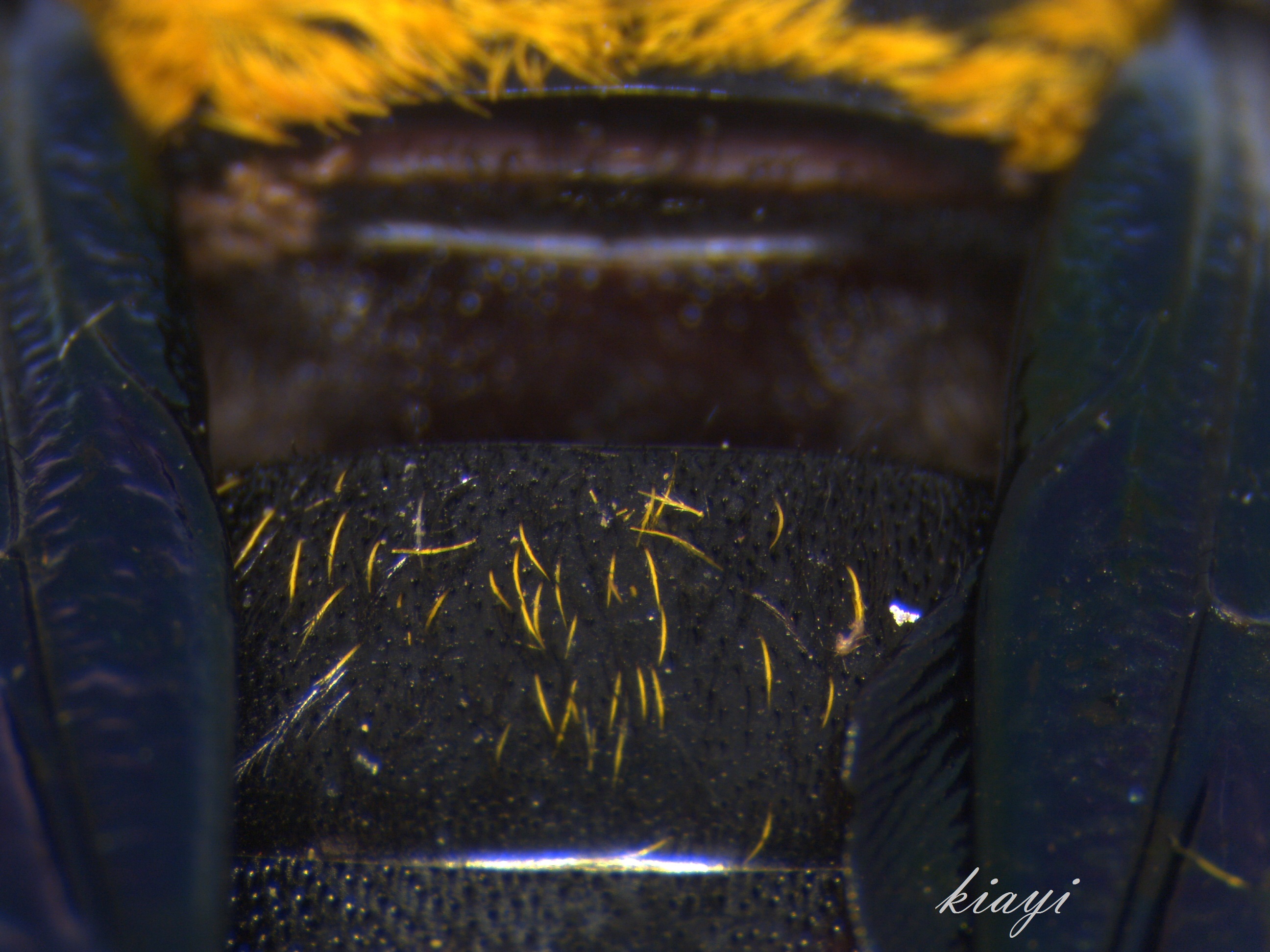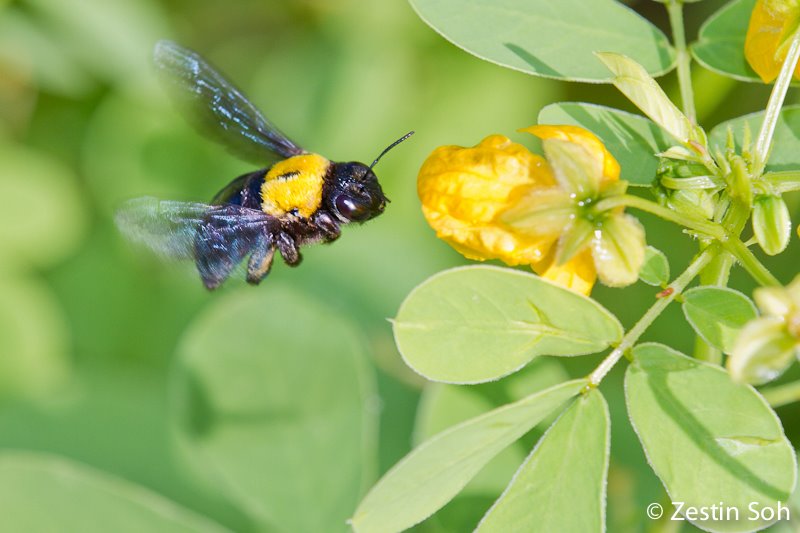 |
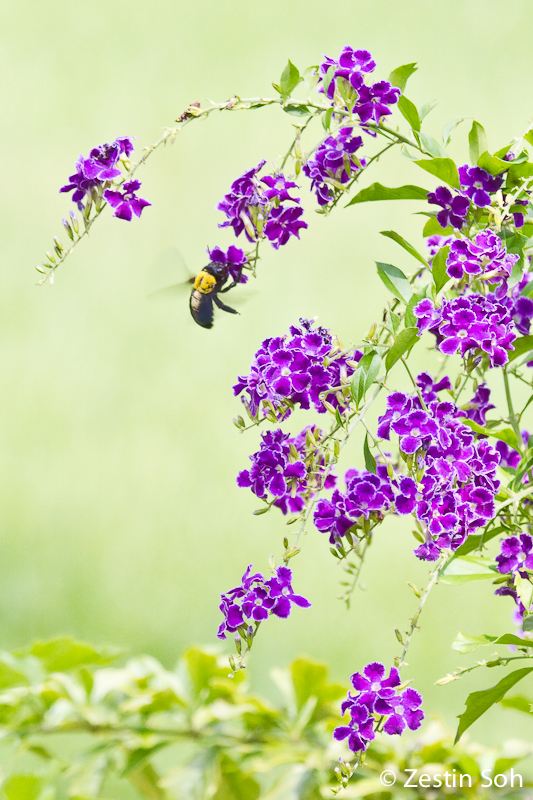 |
| Xylocopa aestuans foraging at floral resources. (Photos by Zestin Soh) |
|
Table of Contents
[1] Introduction
Most people think of bees as either honey bees or bumble bees, which live in large hives, make honey, and serve their queens. However, bee diversity far exceeds this simple image we have. Bee sociality can lie anywhere on the spectrum from the eusocial (like honey bees) to the solitary and anywhere in between. Bees also come in a range of colours - from the usual black and yellow to bright blue! Singapore is home to a high but relatively unstudied diversity of bees. One group of such bees are the carpenter bees (genus Xylocopa). All in all,we share our world with over 730 species of carpenter bees across 48 taxa of Xylocopa [7].
[1.1] Carpenter Bee Starter Facts
- Carpenter bees are subsocial bees - They do not live in hives and every female is reproductively viable. They occasionally exhibit social behavior whereby one or two female adults share a single nest.
- They do not ingest wood - They are named for their ability to bore into wooden structures and nest in them (Fig 1)
- They can sting multiple times - Unlike honey bees which have hooked stings, many bees including the carpenter bee have straight stings and can therefore sting repeatedly. However, only females have stings and are reluctant even so to sting unless under extreme provocation (for example, in defence of their nesting holes)
- They have 5 eyes in total! - They have 2 compound eyes and 3 simple eyes. The simple eyes are called ocelli (singular ocellus) and are simple light receptors (Fig 2)
- They are important pollinators - Carpenter bees are effective pollinators of various plants in Singapore, especially for flowers of larger sizes
- The males and females of Xylocopa aestuans look very different - Xylocopa aestuans and many other Xylocopa species exhibit sexual dimorphism, whereby males and females look superficially different. (Fig. 3 and 4)
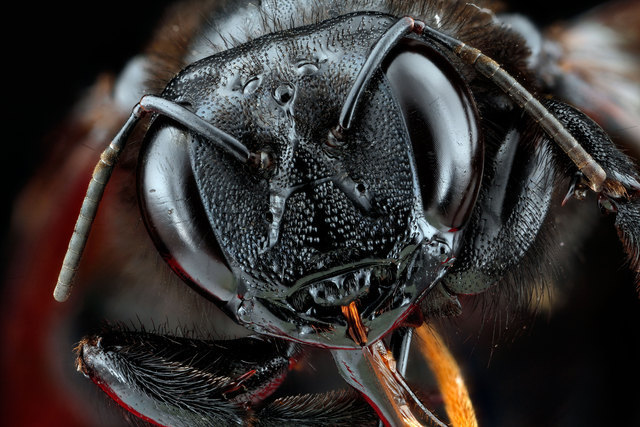 |
|
| Figure 1. Xylocopa aestuans (back view) in the nest bored into dead wood (Photo by Kia Yi Ng) |
Figure 2. Three ocelli visible on top of the head of Xylocopa sonorina (Photo from Discoverlife) [2] |
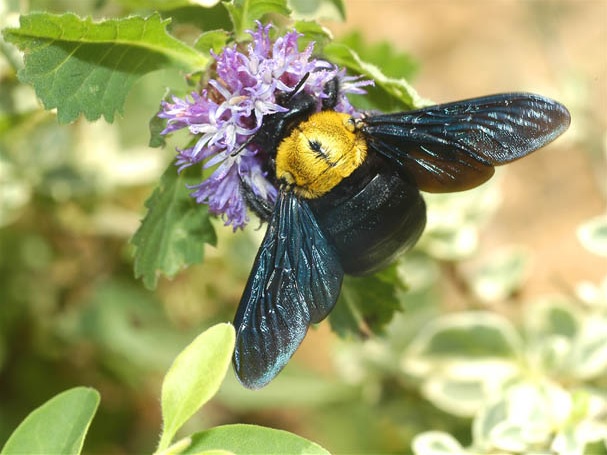 |
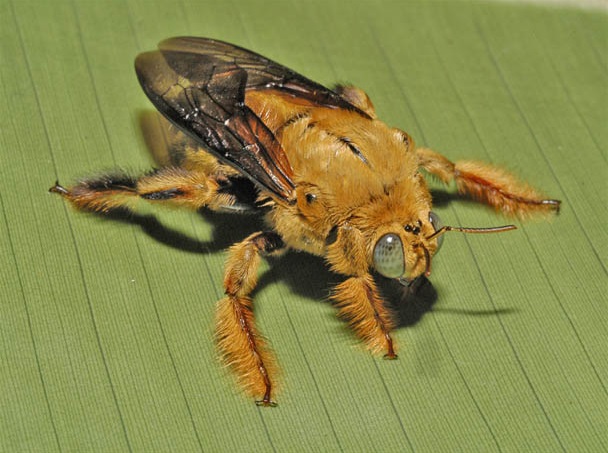 |
| Figure 3. Xylocopa aestuans female (Photo by John X. Q. Lee) |
Figure 4. Xylocopa aestuans male (Photo by John X. Q. Lee) |
[1.2] Other species of carpenter bees found in Singapore
Apart from Xylocopa aestuans, Singapore is home to about 9 known species of carpenter bees (Soh, personal communication, 2014) Figures 5 to 7 are examples of these other species of carpenter bees. Each species of carpenter bee is unique in their own way so do look out for them among the floral resources around Singapore!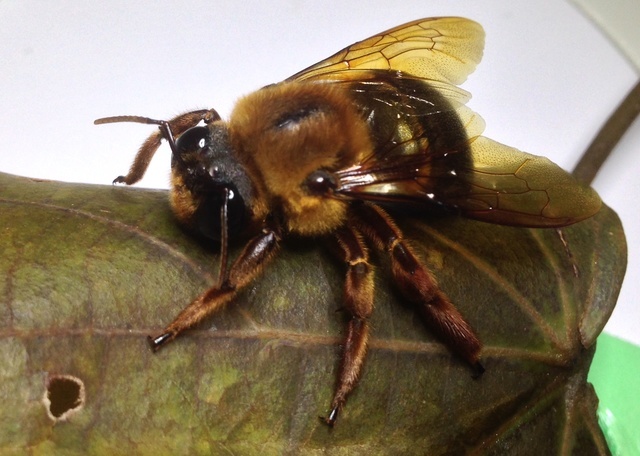 |
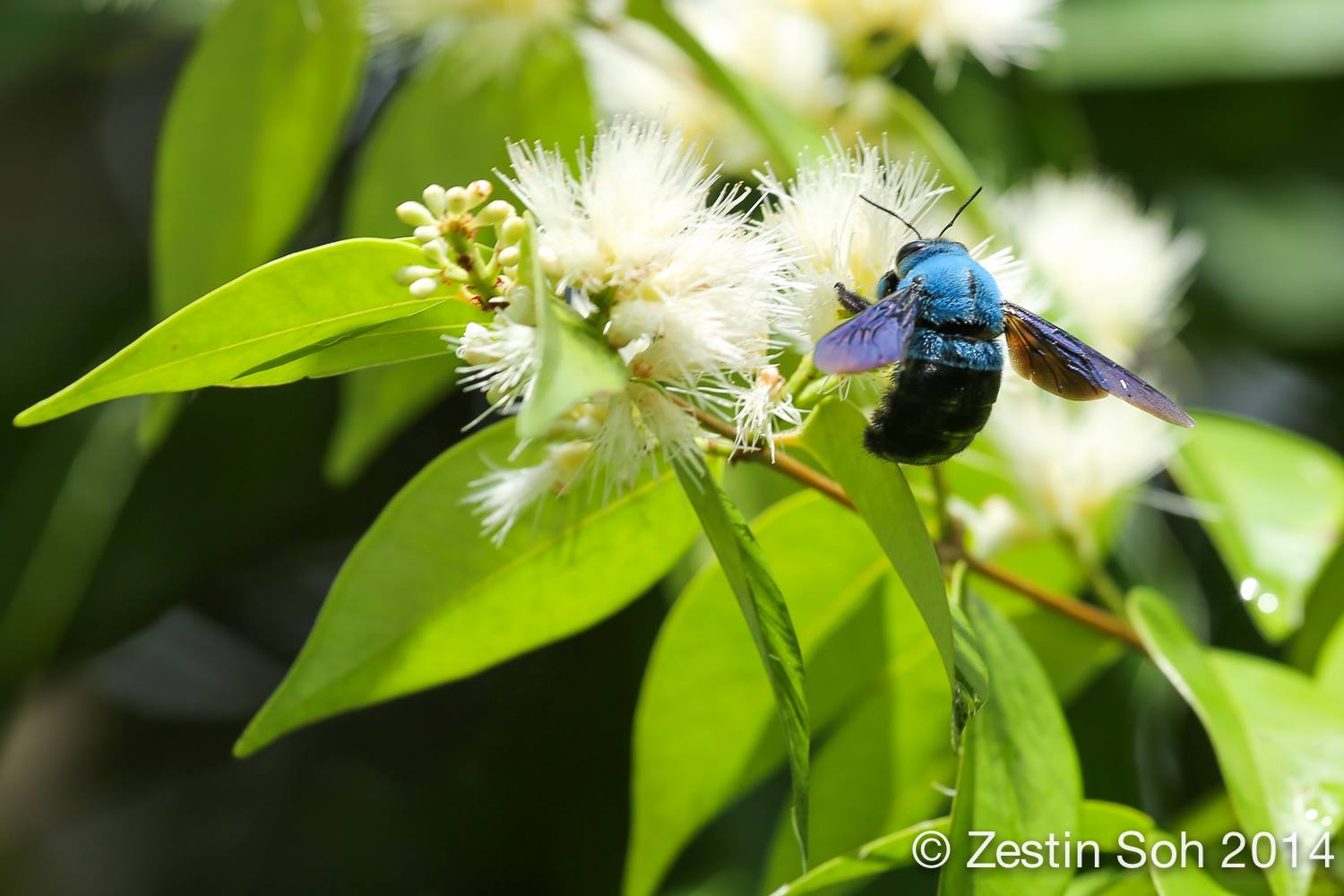 |
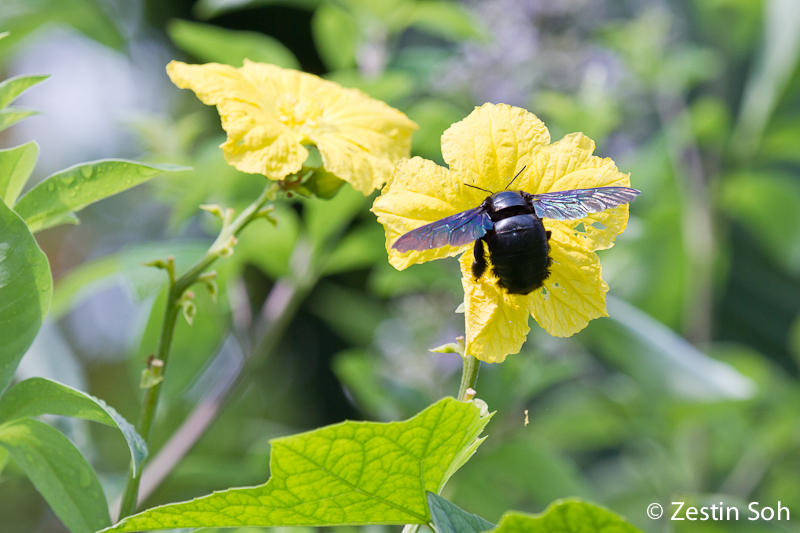 |
| Figure 5. Xylocopa myops, a nocturnal carpenter bee. Note its interesting sepia tint colouration that most probably confers better camouflage from predators (Photo by J. S. Ascher) |
Figure 6. Xylocopa caerulea, a beautiful blue carpenter bee (Photo by Zestin Soh) |
Figure 7. Xylocopa latipes, Singapore's largest bee (and also one of the world's largest) which usually reaches or even exceeds 34mm (Photo by Zestin Soh) |
[1.3] Etymology
Xylocopa comes from the Greek word "xylokopos", meaning woodcutter. 'Xyl' as in xylem refers to wood, while 'kopos' stems from koptein, which means to cut off. The name refers to the unique ability of Xylocopa bees to excavate and utilize wooden structures as nests.[2] Morphology
A detailed version of the labeling of bee body parts can be found HERE.
This section will map out the superficial differences between:
1. Male and female Xylocopa aestuans
2. Male Xylocopa aestuans and male Xylocopa flavonigrescens
3. Female Xylocopa aestuans and female Xylocopa flavonigrescens
[2.1] Xylocopa aestuans
| Sex |
Male |
Female |
|---|---|---|
| Picture (Photos by Zestin Soh) |
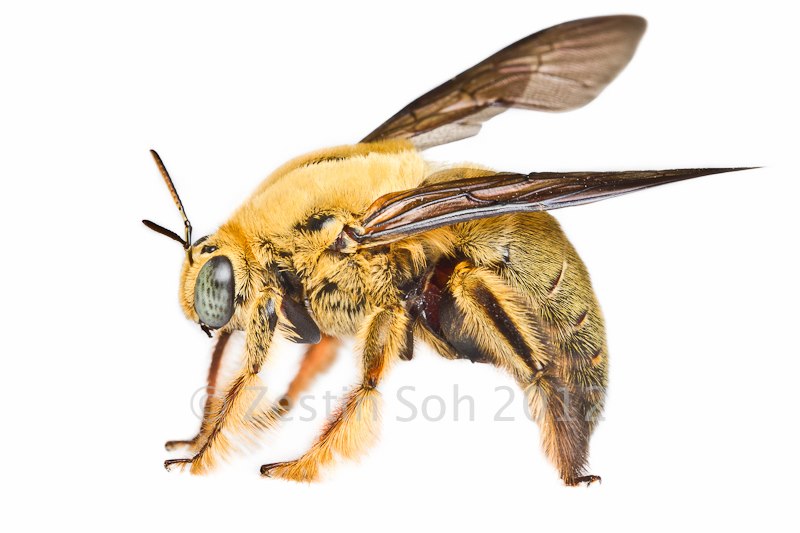 |
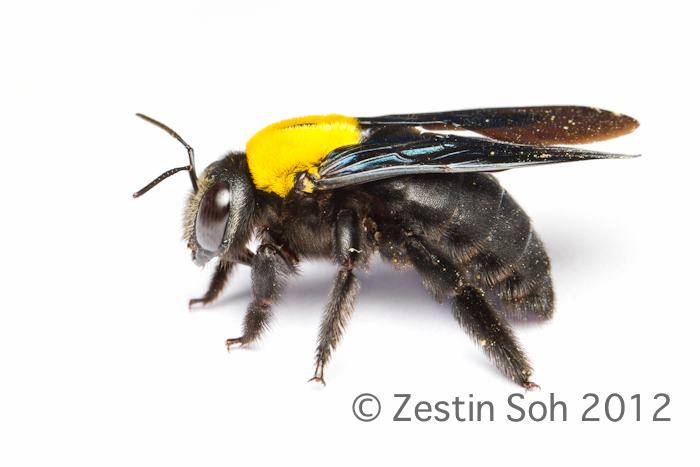 |
| Eye colour* |
Greenish-blue eye colour |
Brownish-black eye colour |
| Body colour |
Yellow throughout body, including undersides of body |
Body black apart from thorax |
| Size |
~20mm |
~20mm |
[2.2] Xylocopa aestuans vs Xylocopa flavonigrescens
Xylocopa aestuans and Xylocopa flavonigrescens (Smith, 1854) [3] are cryptic species, meaning, they look exceedingly alike. Male bees are easier to differentiate while females may require experience and a skilled eye. Their superficial similarities have caused confusion even up till recent times where both species were called Xylocopa confusa and not differentiated.[2.2.1] Males:
| Species |
Xylocopa aestuans (Male) |
Xylocopa flavonigrescens (Male) |
|---|---|---|
| Pictures (Photos by Zestin Soh) |
 |
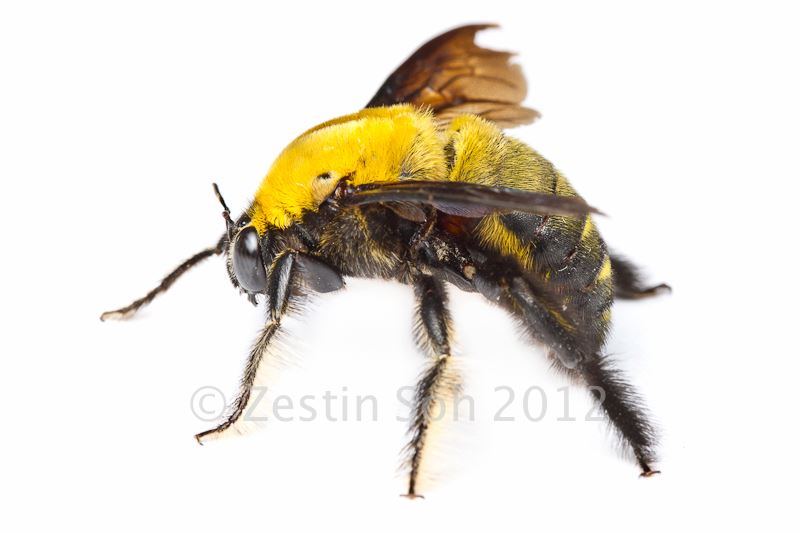 |
| Eye colour* |
Greenish-blue |
Black |
| Body colour |
Fully covered with yellow hairs including head and underside. Yellow is paler. |
Underside is covered in black hair. Abdomen gradually darkens towards posterior end. Yellow is more vibrant. |
[2.2.2] Females:
| Species |
Xylocopa aestuans (Female) |
Xylocopa flavonigrescens (Female) |
|---|---|---|
| Top view (Photos by Kia Yi Ng) |
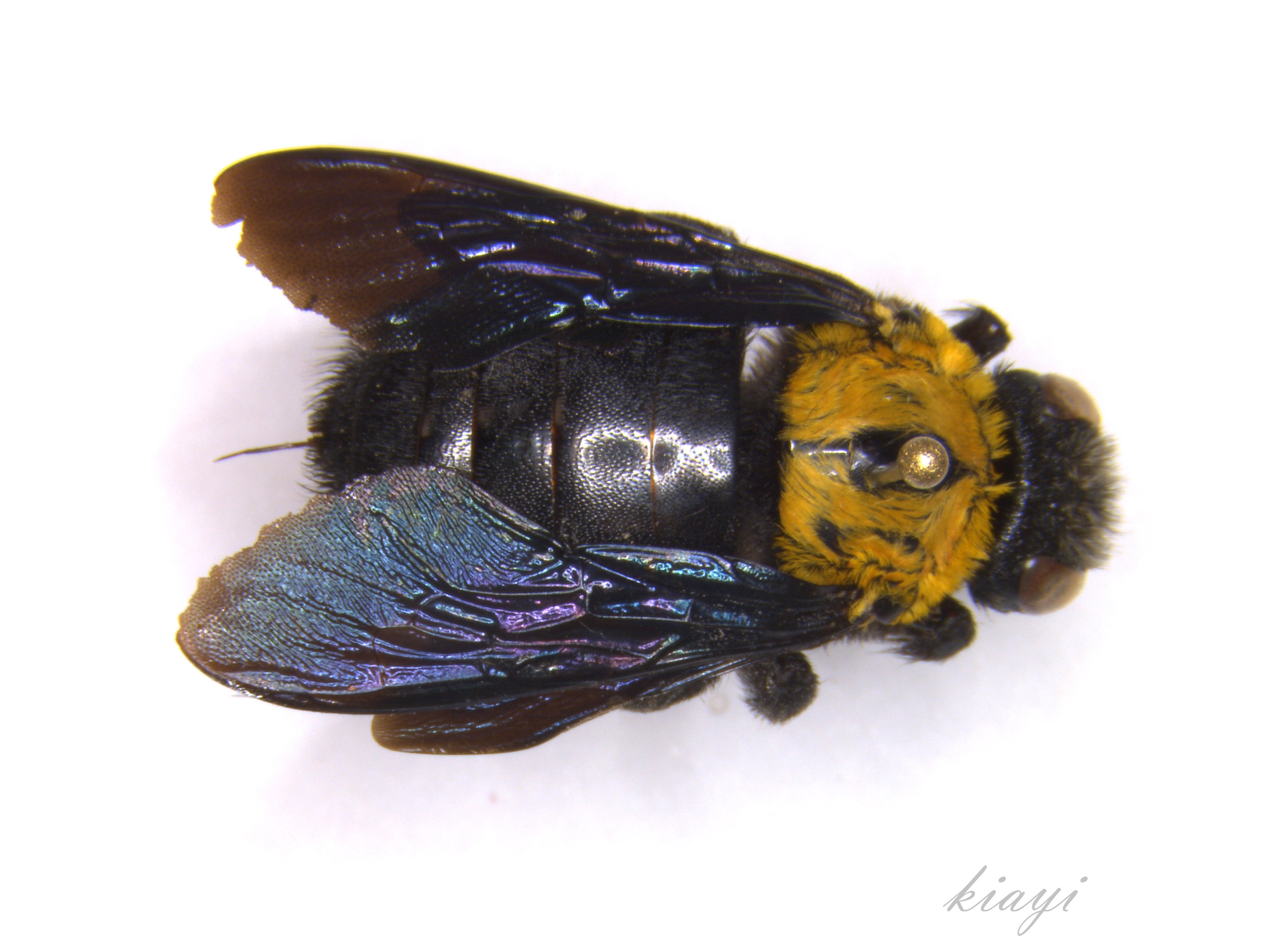 |
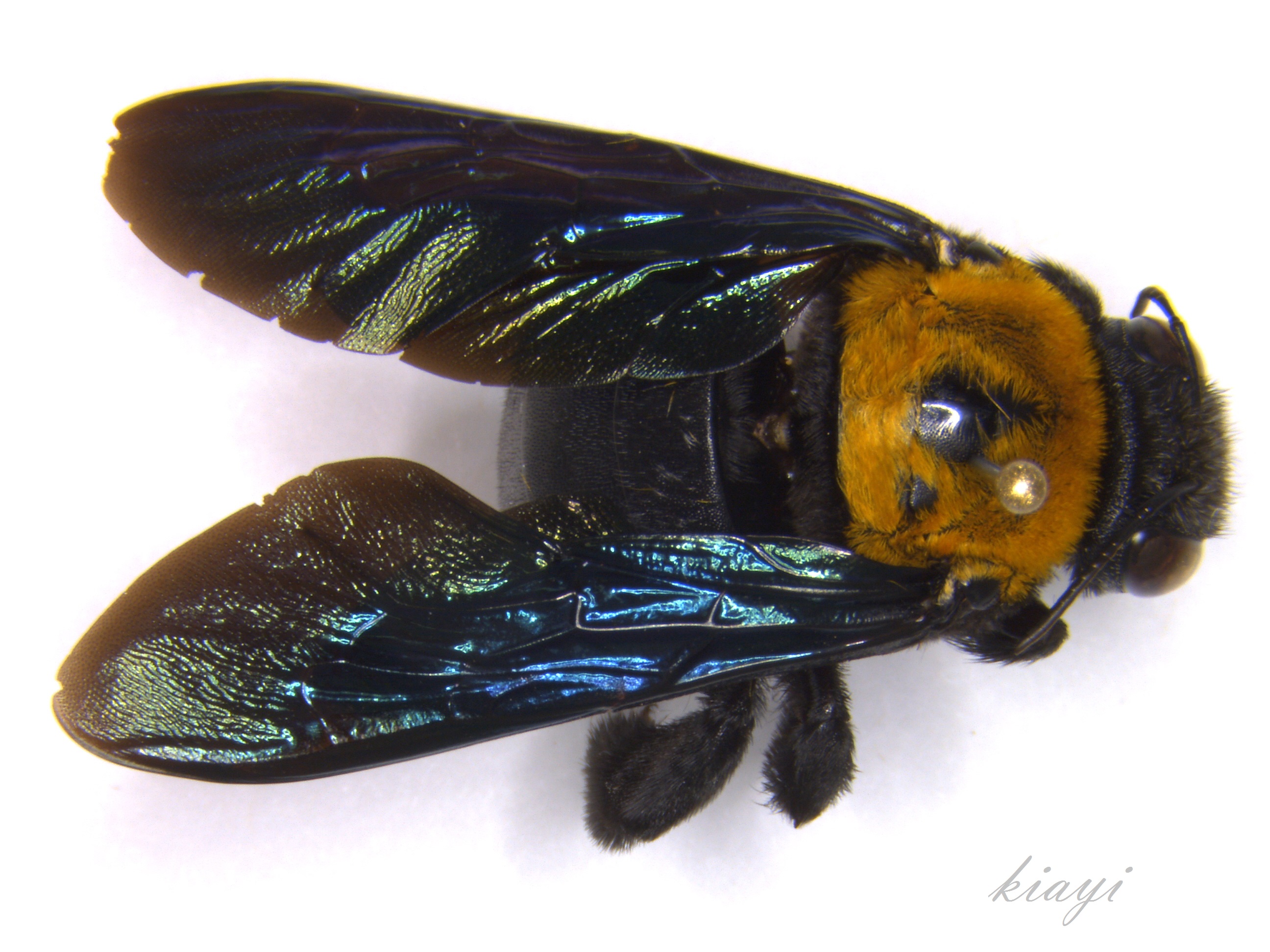 |
| Side View (Photos by Kia Yi Ng) |
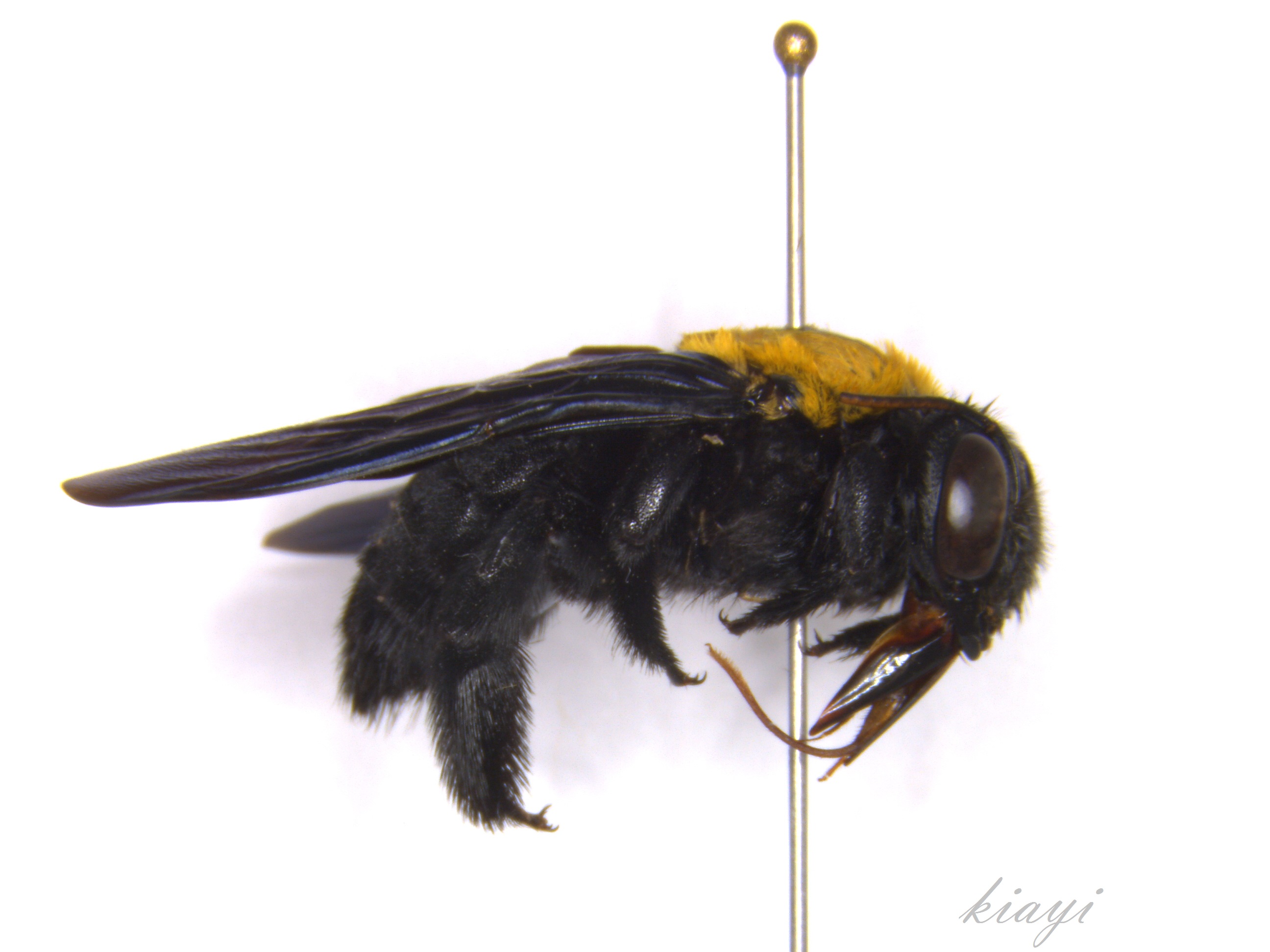 |
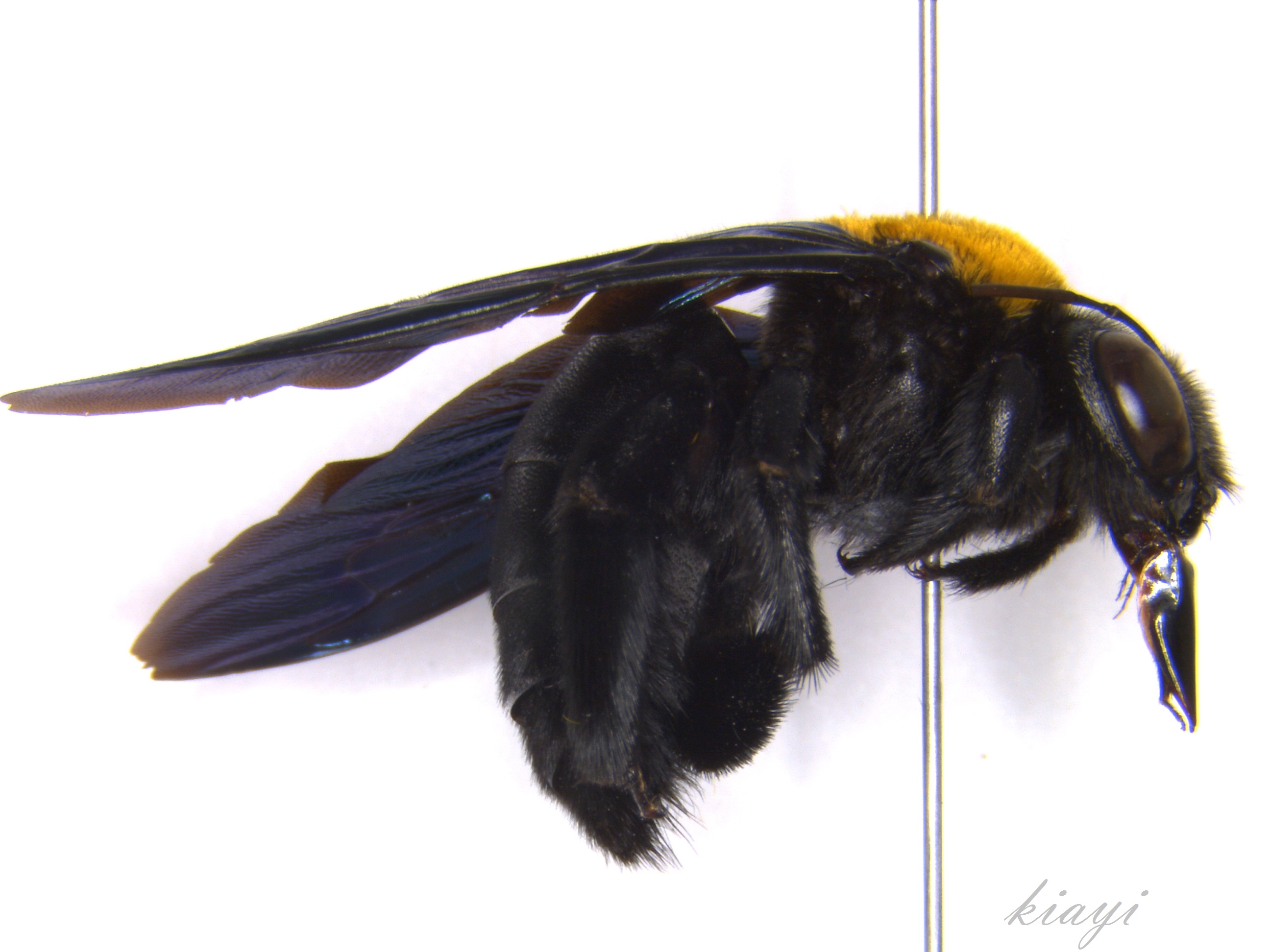 |
| Size |
~20mm |
~24mm |
| First tergum (First abdominal segment) |
Absence of yellow hairs |
Presence of yellow hairs |
| Metanotum (Segment in between thorax and abdomen) |
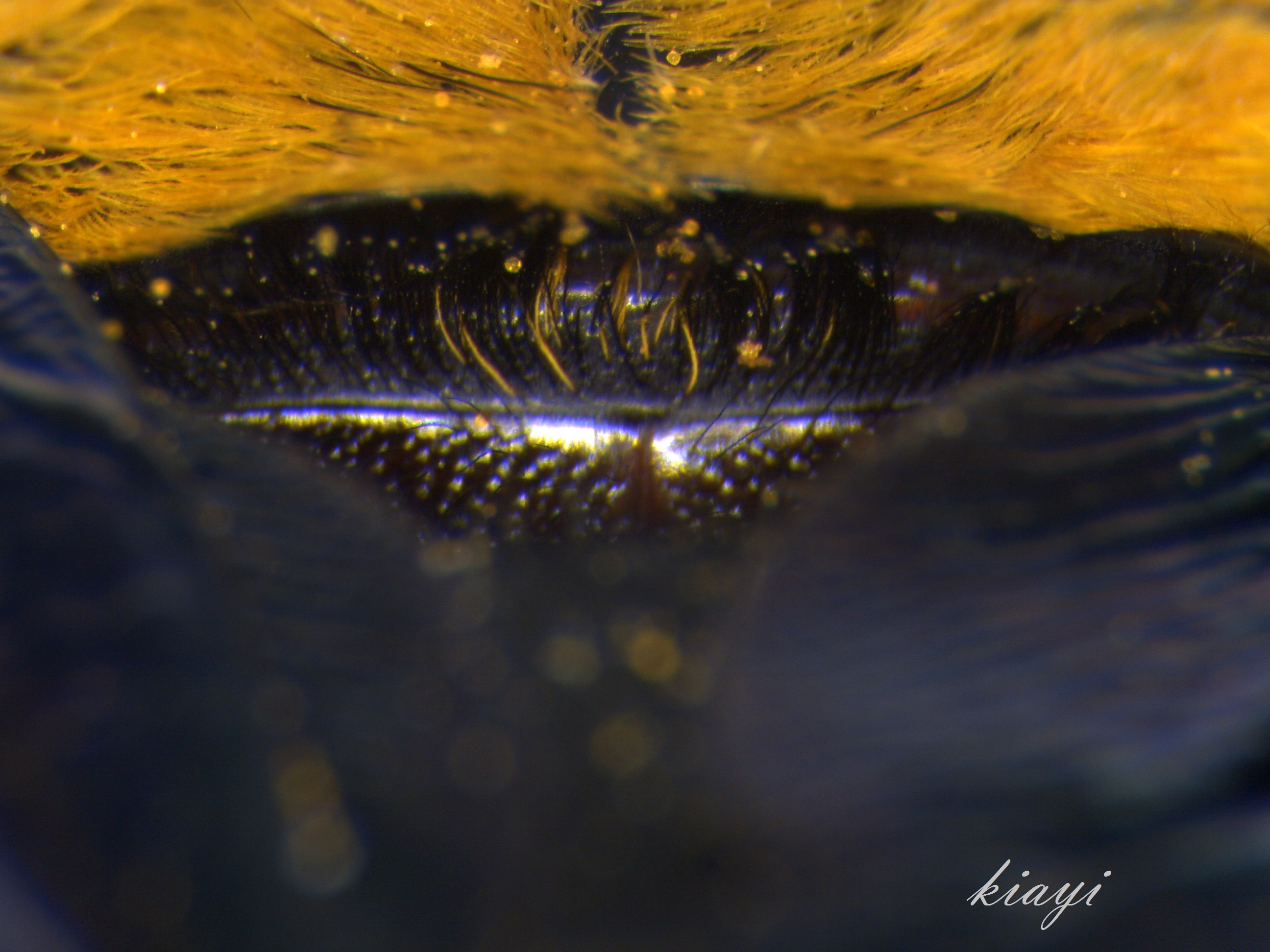 Presence of yellow hairs |
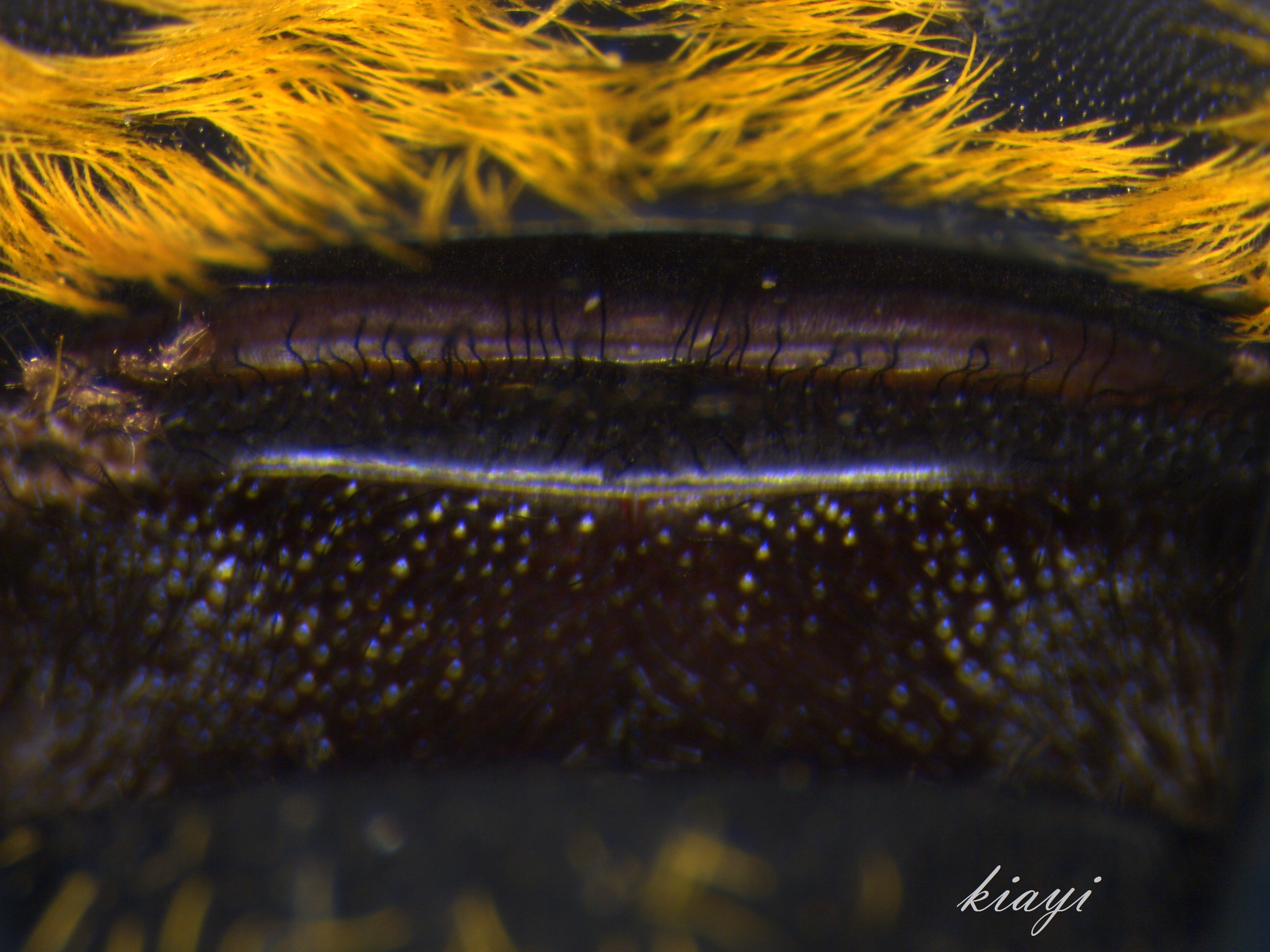 Absence of yellow hairs |
| Gena (cheeks) |
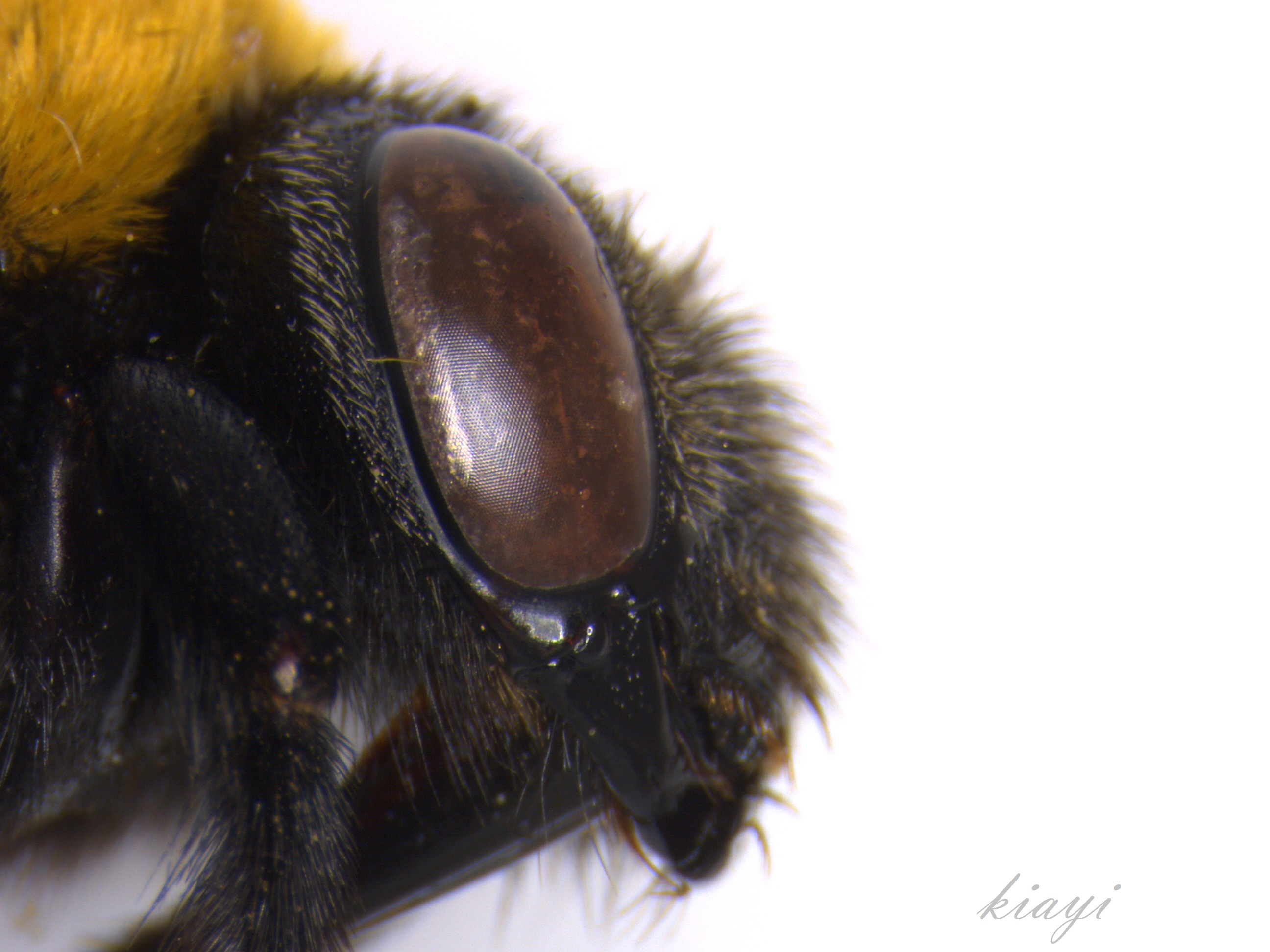 Presence of white hairs |
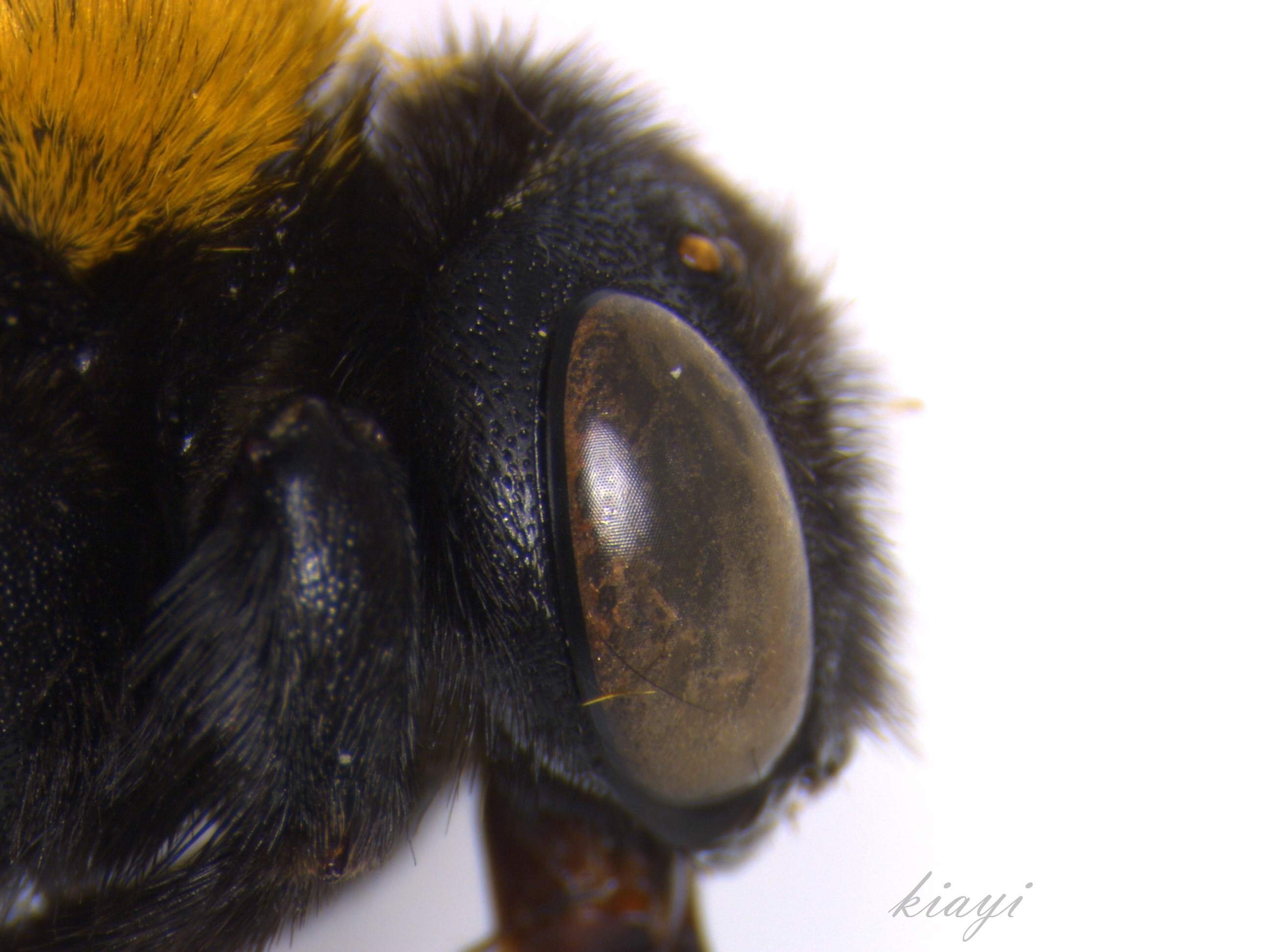 Absence of white hairs |
| First abdominal tergum (T1) |
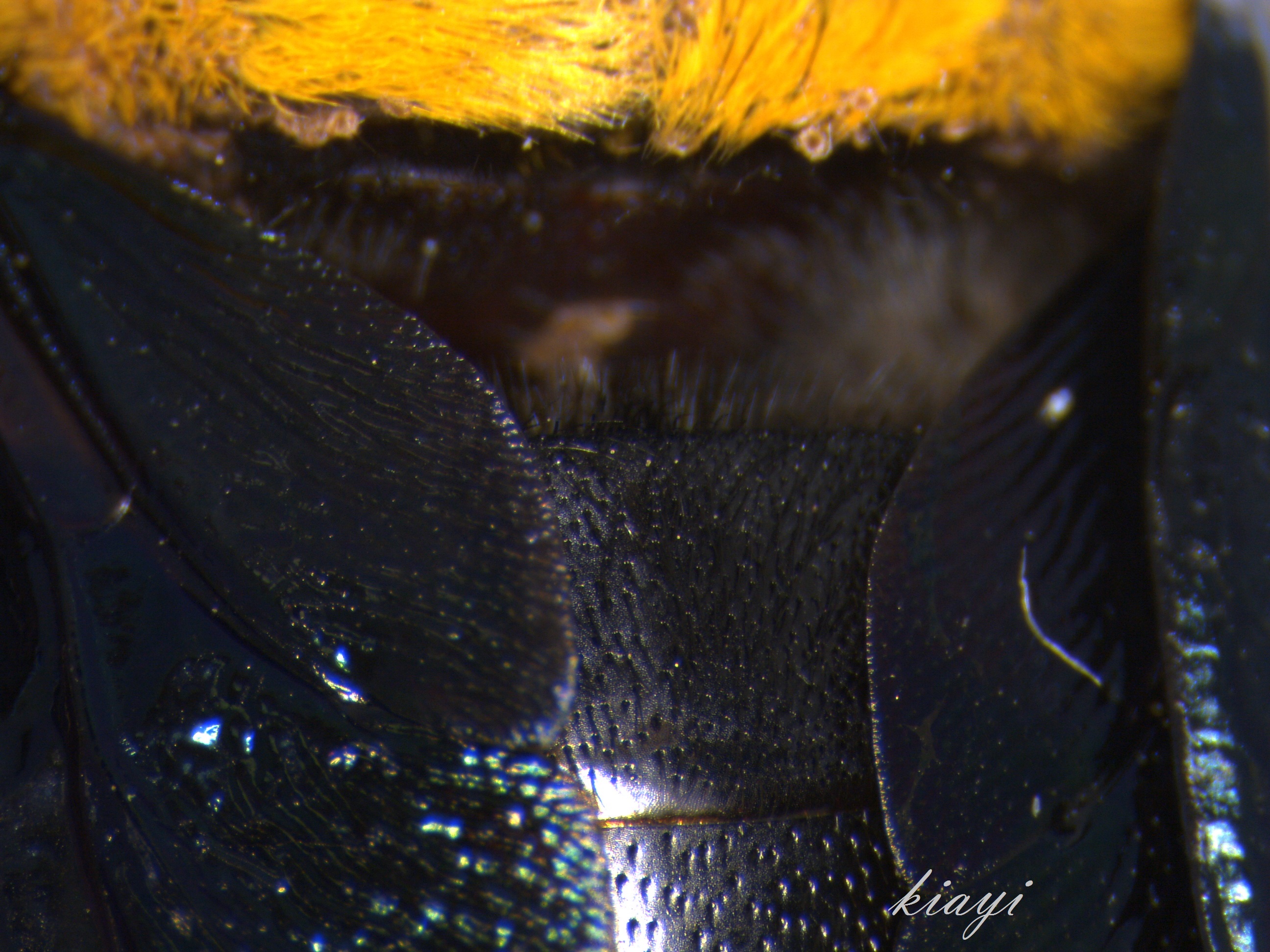 Absence of yellow hairs |
Presence of yellow hair |
| Wing Colour (Dried and under florescent lighting) |
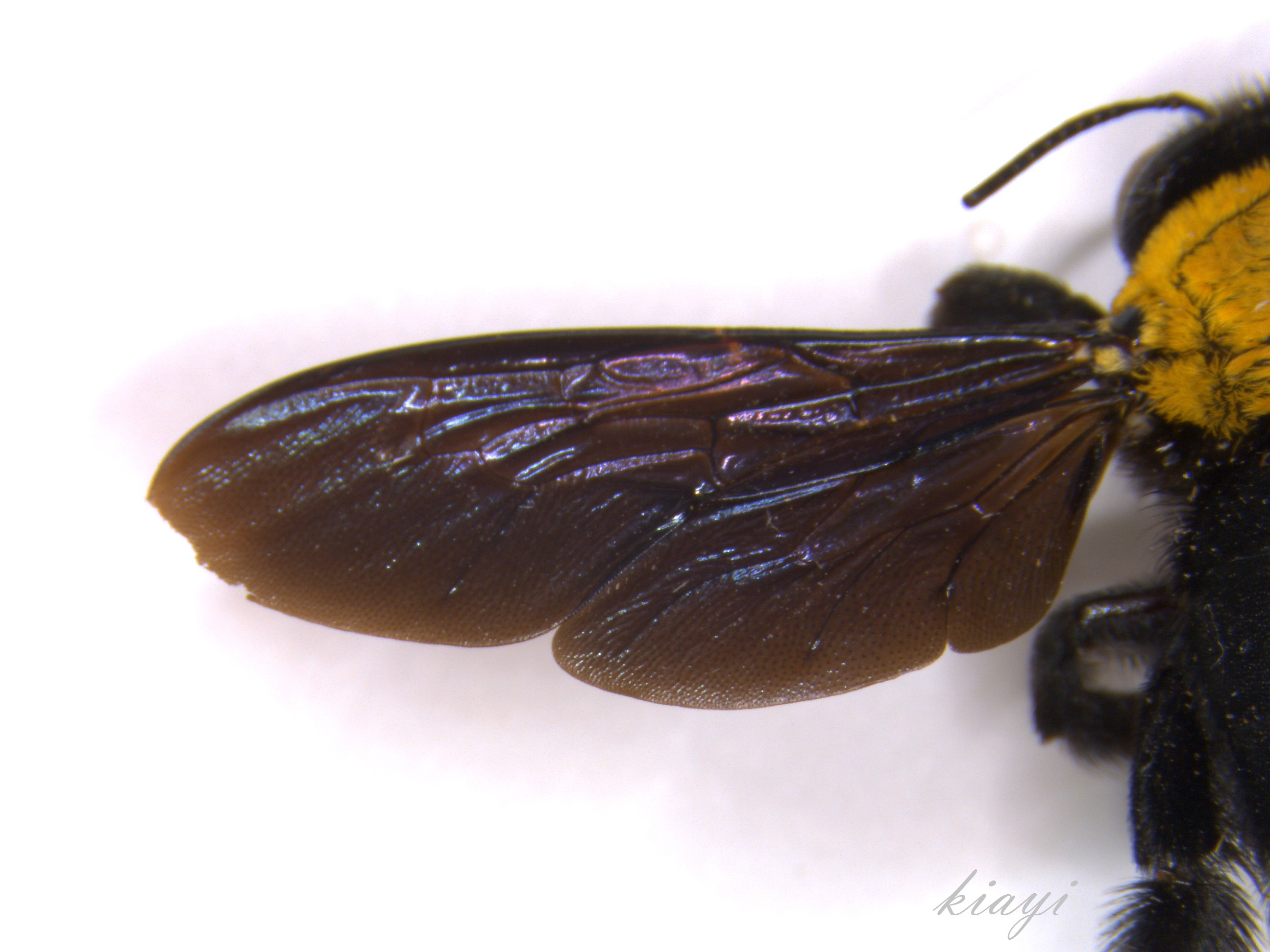 Purple iridescence |
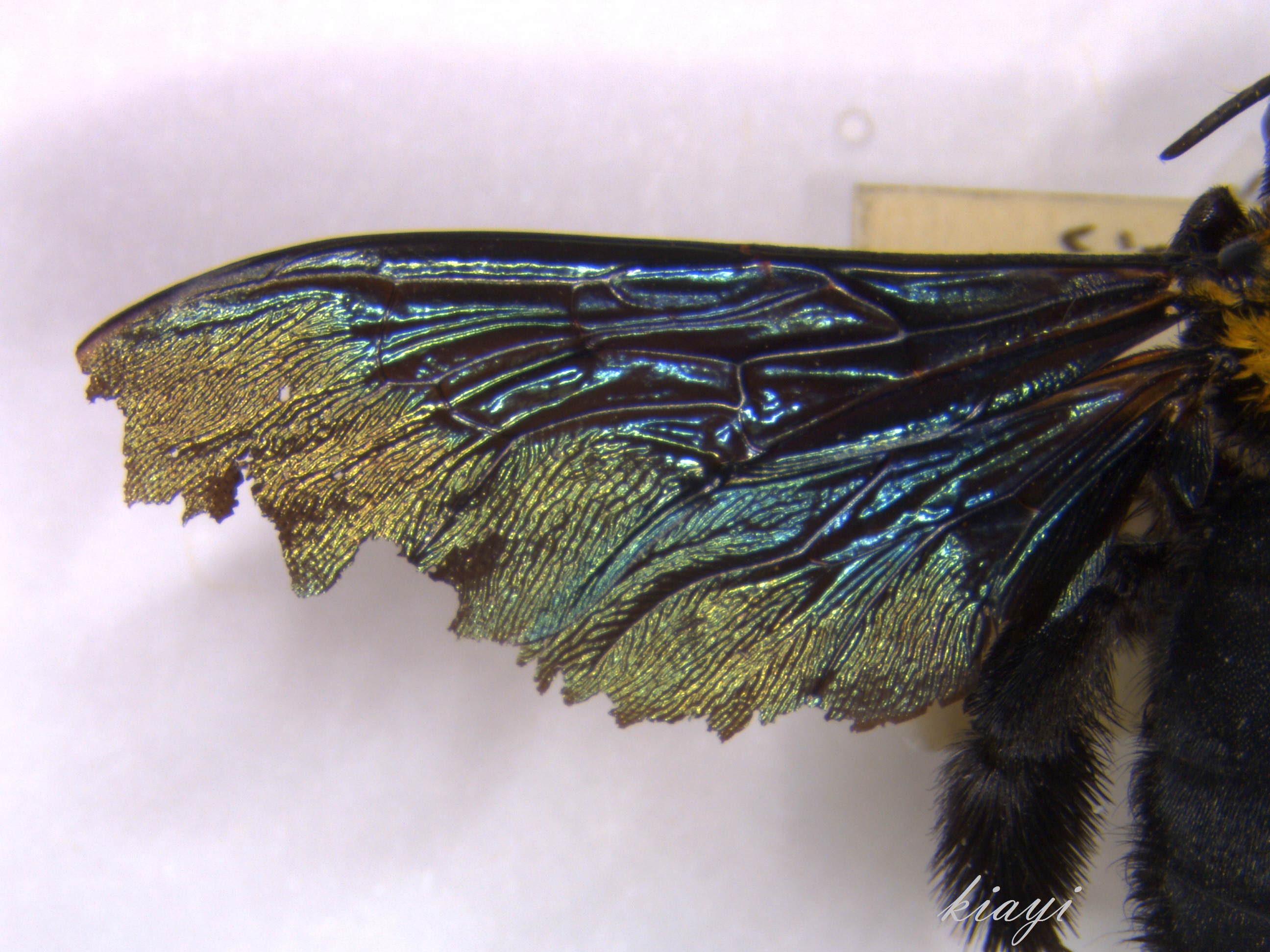 Green iridescence |
[3] Distribution
[3.1] Habitat
Xylocopa aestuans is found in the tropical regions of the world. They are not fussy about their habitat and can be found anywhere as long as food resources and nesting sites are available. This may include primary forests, secondary forests, urban gardens, urban parks and can even be found nesting in man-made structures such as garden sheds or wooden pillars (observation, 2014).Xylocopa aestuans seems to have adjusted relatively well to urbanisation in Singapore as they are able to exploit man-made green areas successfully. In fact, they are seen very often in urban parks and gardens as these places tend to have higher flower densities due to cultivation for aesthetic purposes (Ascher, personal communication, 2014). However, their exact preference between natural and man-made habitats has not been thoroughly researched. Additionally, since Xylocopa bees also are known to pollinate flowers of forest canopies (Ascher, personal communication, 2014), the difficulty in spotting them from the ground makes it even harder to determine their preference and hence assess how they have been impacted by urbanisation.
[3.2] Global Distribution
 |
| Figure 8. Global distribution of Xylocopa aestuans (Map edited with permission pending from Discoverlife) [2] |
- The record in Europe is highly likely to be erroneous as Xylocopa aestuans is a tropical species.
- African and Middle-Eastern findings should be reconfirmed as records may have been confused with the morphologically similar Xylocopa pubescens.
- New Guinea records evidently pertain to Xylocopa aruana or Xylocopa lundqvisti (Lieftinck, 1964).
- There have been records of Xylocopa confusa (a junior synonym for Xylocopa aestuans) in Timor (Lieftinck, 1957) and Cambodia (Sakagami, 1960), which have not been accounted for in this map.
Countries currently confirmed to have Xylocopa aestuans:
Saudi Arabia, United Arab Emirates, Pakistan, India, Nepal, Malaysia, Singapore, Burma, Borneo, Thailand, Vietnam, Cambodia, Indonesia, Flores, Timor Java, Lombok
[3.3] Distribution across Singapore
Googlemaps: Xylocopa aestuans is distributed all over Singapore. Some bias towards relative ease of survey is expected in this distribution.
From: NUS Bee Lab (collected by J. S. Ascher, S. H. Chua, S. X. Chui, K. Y. Ng, Z. W. W. Soh, E. J. Y. Soh, J. W. T. Tan, and K. S. Yow)
[4] Diet
[4.1] Adult
Xylocopa aestuans are floral generalists that will go for just about any flowers that can accommodate their size. Bees are able to perceive ultraviolet (UV) light, which humans cannot. As a result, flowers that have UV floral patterns or reflect UV rays (eg. blue or white flowers) may attract more bees (Fig 9) [10].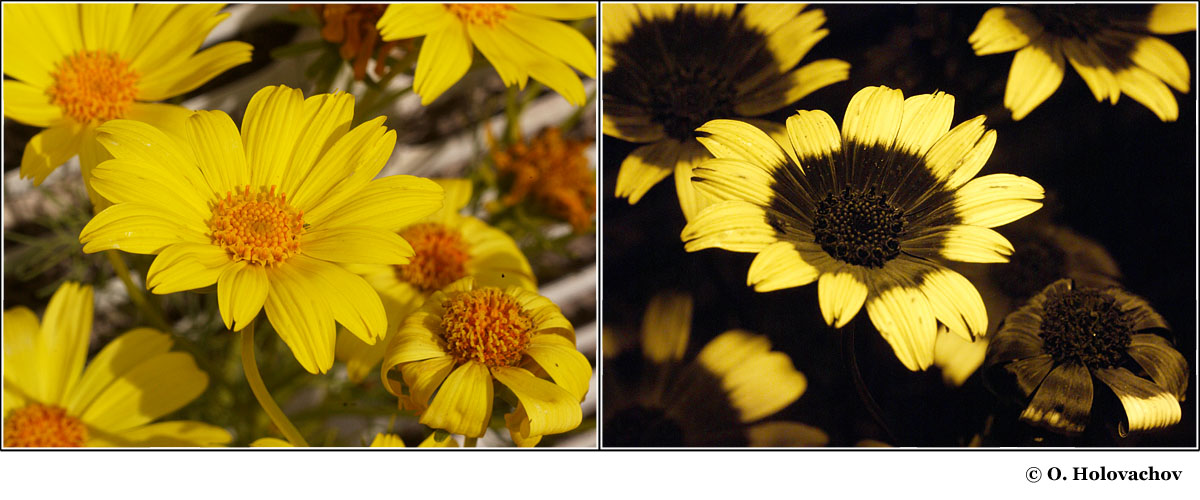 |
| Figure 9. Flowers as humans perceive it (left) and flowers with UV light visualised (right), which is possibly what the bees perceive. (Photo by O. Holovachov) |
[4.1.1] Buzz pollination
In addition to normal pollination, Xylocopa aestuans (and certain other bees including Amegilla zonata) can carry out a special type of pollination called buzz pollination (Vid. 1). Buzz-pollinated flowers release their pollen when hit with a certain frequency. The bees carry out buzz pollination by holding on to the flower and shivering their indirect flight muscles, generating an audible buzz [5]. They may buzz singularly or multiple times till satisfactory amounts of pollen have been gathered, mainly on their head and thorax. Bees then groom this pollen using their forelegs to concentrate the pollen on their hind legs [1].[4.1.2] Nectar robbing
Xylocopa aestuans also practice nectar robbing where they cut through open the tubular bases of flowers with their proboscis to obtain nectar from the flower without the act of pollination (Vid. 2). Nectar robbing is a viable method to obtaining nectar from otherwise unsuitable flowers, such as flowers that have too small an opening for the bee's bulk or for flowers which have a long penduncle (which is more suitable for a butterfly's long probiscis). This not only damages the plant but also largely decreases the amount of nectar obtained by legitimate pollination by other bees [12]. The hole cut by Xylocopa may also be exploited by secondary nectar robbers such as Amegilla, which have mandibles too weak to cut into the thick flower structures and would therefore be unable to exploit these nectar sources.| Video 1. Buzz pollination by various bees (including bees outside of the Xylocopa genus) |
Video 2. Nectar robbing by Xylocopa appendiculatar (not found in Singapore) on the flowers of the Plantain Lily |
[4.2] Juvenile
By mixing nectar and pollen in a certain ratio, female bees provision her offspring with a food mass known as bee bread, which the larvae feed on upon hatching from their eggs. Xylocopa bee bread is loaf-shaped and partly supported by the egg, possibly to minimise contact with the cell surface in order to avoid mold formation, which may destroy the food source [12].[5] Behavior
[5.1] Foraging
Xylocopa bees are most active foraging during the morning from approximately 8am to 11am (observation, 2014). This observation is similar to that of Xylocopa torrida (not found in Singapore) [1]. This may be because the flowers have refilled their nectar overnight and the bee would hence have the highest yield per effort.[5.2] Mating
The mating seasonality of Xylocopa aestuans in Singapore is unknown. However, males have been observed to guard floral resources in anticipation of the arrival of a potential mate (Vid 3). The males would circle the area continuously and may fly towards or chase approaching subjects (other insects or animals including humans) in a bid to protect his turf even if he lacks a sting and cannot really inflict much harm. However, males will beat a hasty retreat should the subject be large and continue to be near the place he is guarding. While male carpenter bees of other species have been seen to congregate at floral resources, each guarding its own patch [1] , only one male Xylocopa aestuans usually guards a single floral resource (observation, 2014). The males may take a break to feed but usually return to guard soon after.There has been no documentation or observation on the mating process of Xylocopa aestuans to date. However the range of mating behaviors exhibited by other Xylocopa species include copulation on the ground, on twigs, and even during flight [1]!
| Video 3. Male Xylocopa aestuans guarding Bougainvillea sp. floral resources atop an overhead bridge in Pasir Ris. (Video by Kia Yi Ng) |
[5.3] Nesting behavior
[5.3.1] Sociality of Xylocopa
Xylocopa aestuans are for the most part, subsocial. Each female is reproductively viable and would independently construct her nest and raise her young. They are tolerant of other individuals and the same piece of wood can house multiple females. However, they do not share nests with other reproductive females or connect their nest tunnels. Carpenter bees seem to have the ability to sense their neighbouring nest tunnels and stop excavation so that two nests never interconnect.The sociality of carpenter bees is very intriguing as different species do exhibit varying but limited degrees of sociality. Due to their close relatedness to sister group Apidae, which contains highly eusocial bees, Xylocopa bees may give us an insight into the evolution of sociality in bees. In a study regarding the closely related Xylocopa pubescens (not found in Singapore), a nest may be shared by a dominant reproductive female and a guard female which is either young and pre-reproductive or old and no longer reproductive. The dominant female can change through a take-over by daughters or intruders, with the victorious female assuming the reproductive role while the defeated female is manipulated into a guard role. The defeated female may leave to find another nest either by constructing or usurping another nest. However, when floral and nesting resources are limited or if the defeated female is too old, she may choose to stay and assume the guard role, being ensured a shelter. A daughter may also help out with her mother's nest in hopes of inheriting the nest in the future [8]. The dominant female benefits from the presence of guard females as they ward against pollen robbers, potential usurpers as well as predators and parasites of their young and allow for longer foraging flights [9].
There is limited research regarding the sociality of Xylocopa aestuans. However, there have been observations of at least 2 adult females within the same nest entrance and is believed that they share similar behavior as Xylocopa pubescens.
[5.3.2] Nest construction
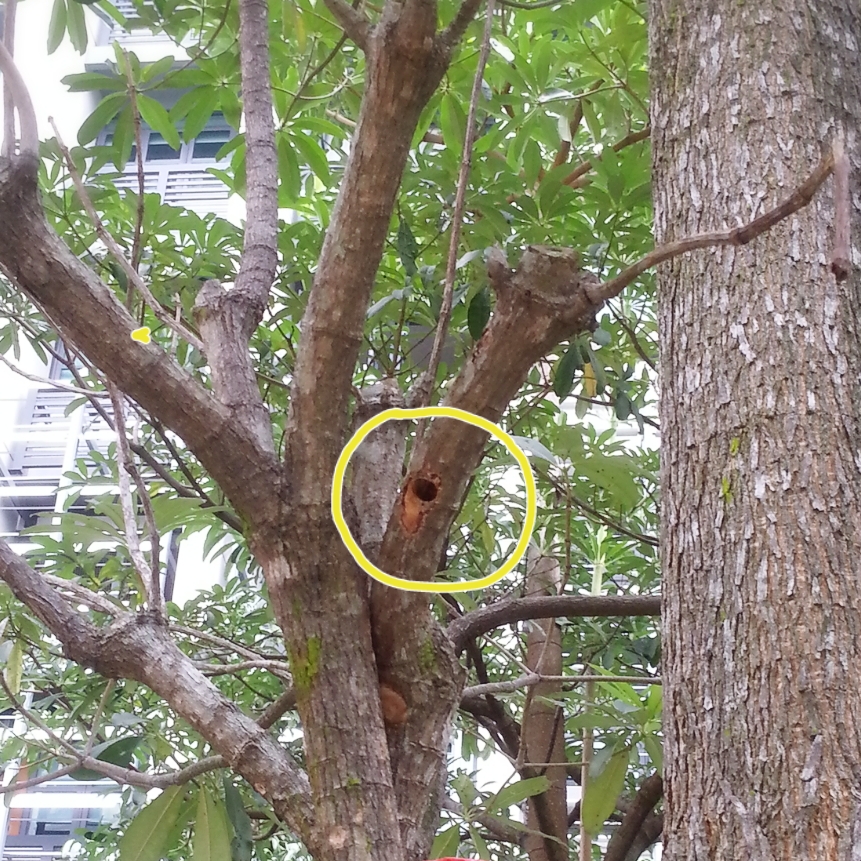 |
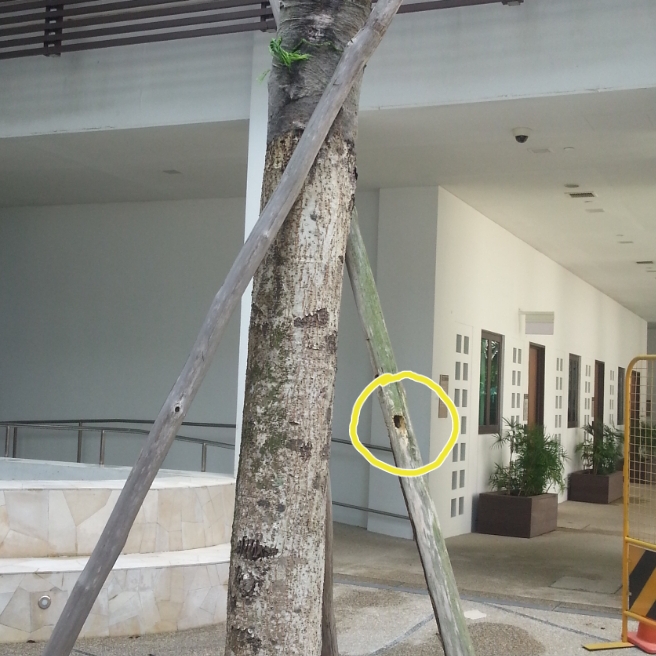 |
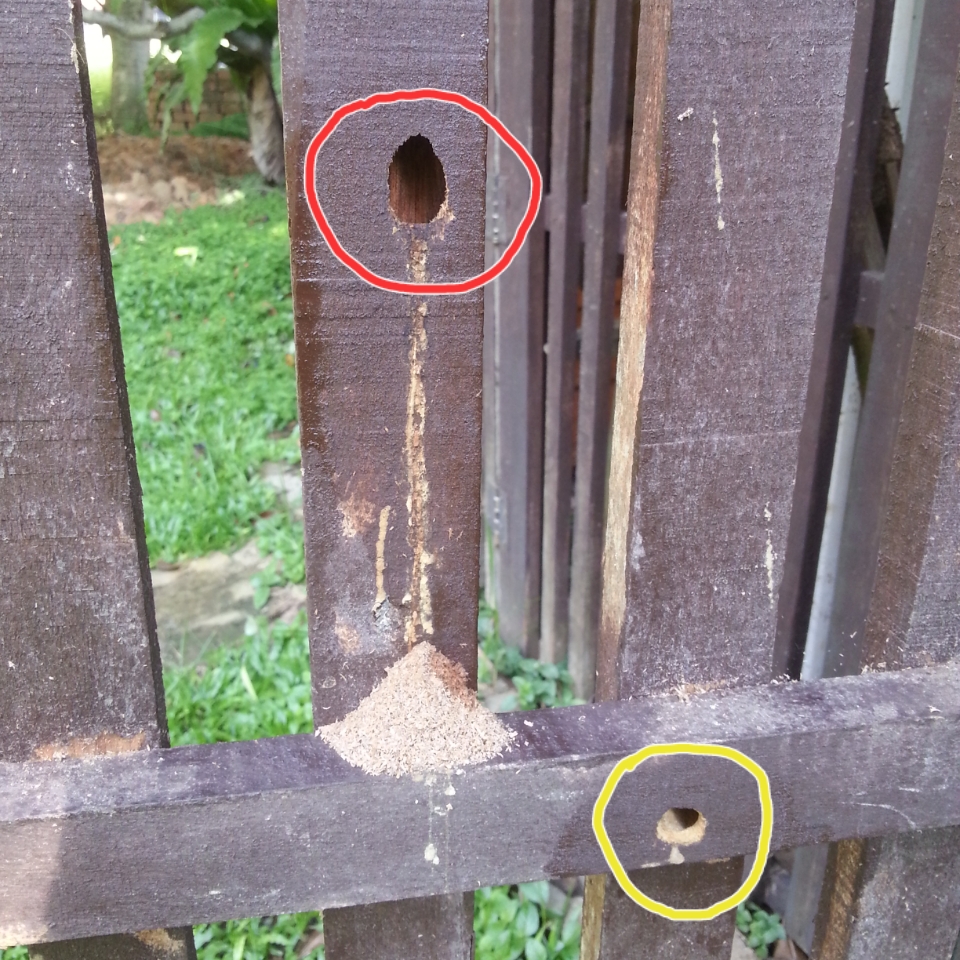 |
|
| Figure 10. Xylocopa aestuans nest in dead branch of tree at NUS university town (Photo by Kia Yi Ng) |
Figure 11. Xylocopa aestuans nest in tree support at NUS university town (Photo by Kia Yi Ng) |
Figure 12. Xylocopa latipes (red circle) and Xylocopa aestuans (yellow circle) nest on wooden shed in Pasir Ris Park. Species is identified by observing the bees exiting the respective nest entrances (Photo by Kia Yi Ng) |
The entrance to the nest is circular, cut perpendicular to the grain of wood and bends into the ascending tunnel. The descending tunnel has a clearly defined ridge leading from the entrance [1]. The above description is similar to those observed for certain species of South African bees (X. imitator, X. torrida and X. flavorufa) although tunnel structure may differ for Xylocopa aestuans. However, Xylocopa aestuans share their preference for tunneling perpendicular to the grain for the entrance and then along the grain for the tunnels.
The number of cells in a nest may vary according to the space made available to them and range typically from 4-7 closed cells [6]. The cells may extend upwards and downwards from the entrance and the bees always completes tunneling the upper cells before the lower cells, possibly due to the increased efficiency of removing sawdust in this manner. The tunnels are usually 3-5mm wider than the diameter of the entrance of the nest which is about ~11 to 15mm [6].
| Figure 13. Test dig by Xylocopa aestuans (Photo by Kia Yi Ng) |
Video 4. Xylocopa aestuans actively excavating her nest (Video by Kia Yi Ng) |
General observations suggest that the bees prefer to, if the material permits, construct the entrance on the side where it angles towards the ground. This may be to avoid rain water water and heat of the sun which reduces the risk of offspring drowning, overheating or stored food resources going bad.
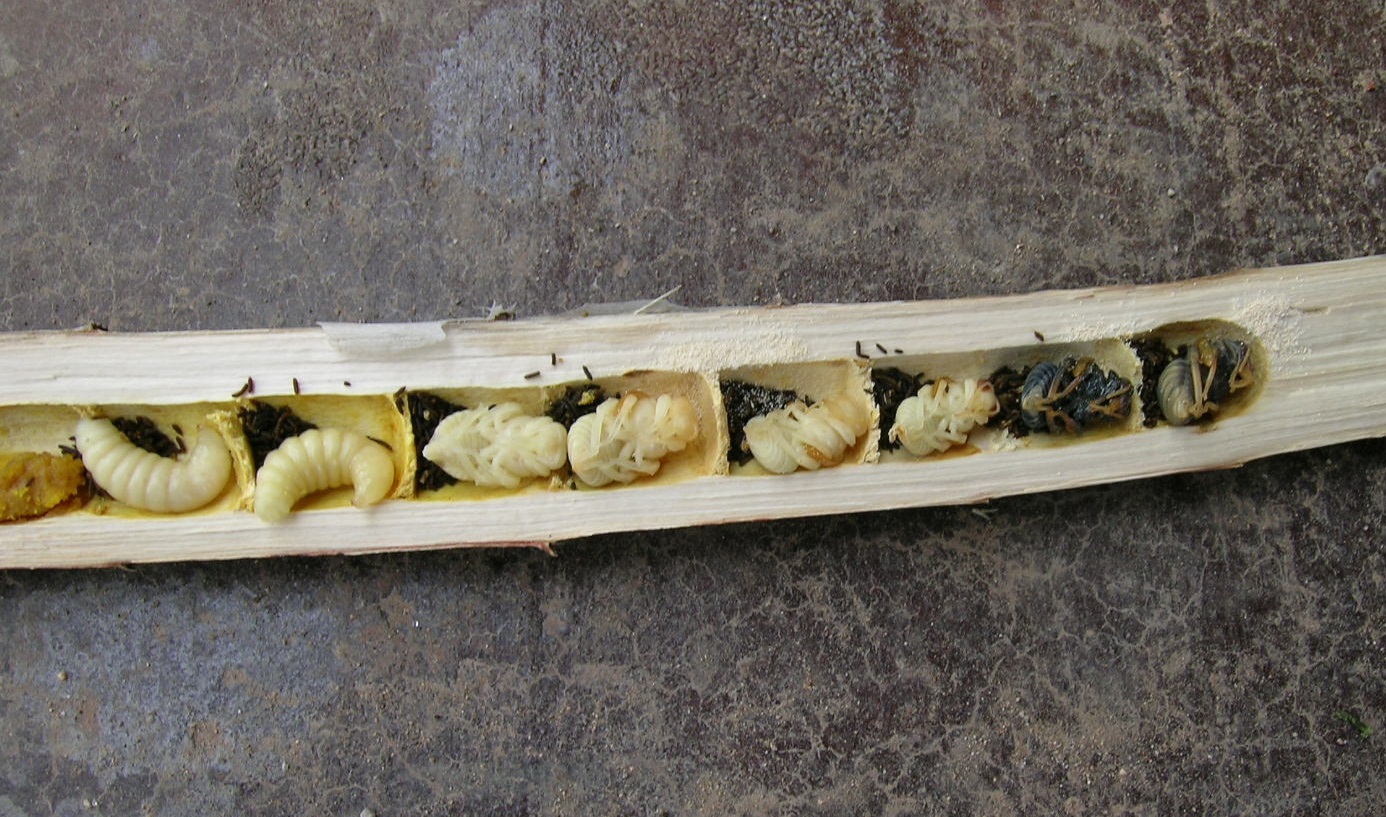 |
|
| Figure 14. Cross section of an unbranched Xylocopa nest collected in Singapore. Species is unclear but suspected to be either Xylocopa aestuans or Xylocopa flavonigrescens. (Photo by NUS Bee Lab) |
Figure 15. Cross section of a Xylocopa sp. nest showing differential development stages. (Photo by Joe, permission pending) |
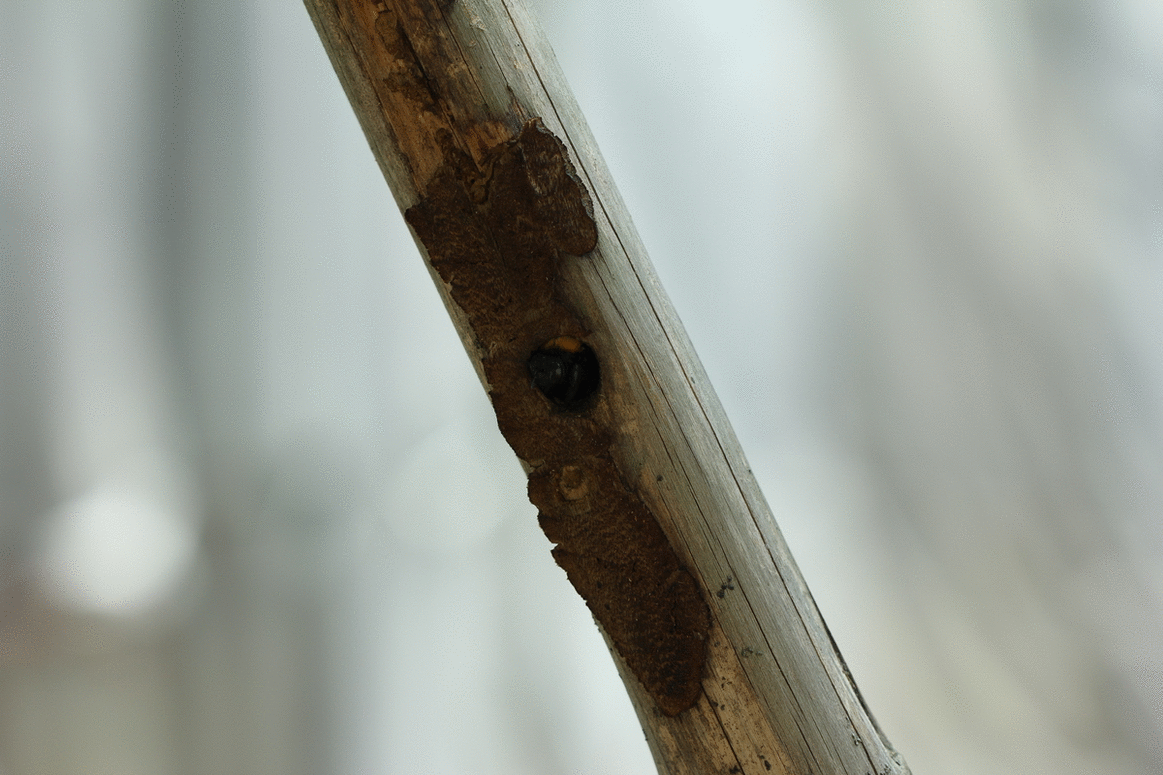 |
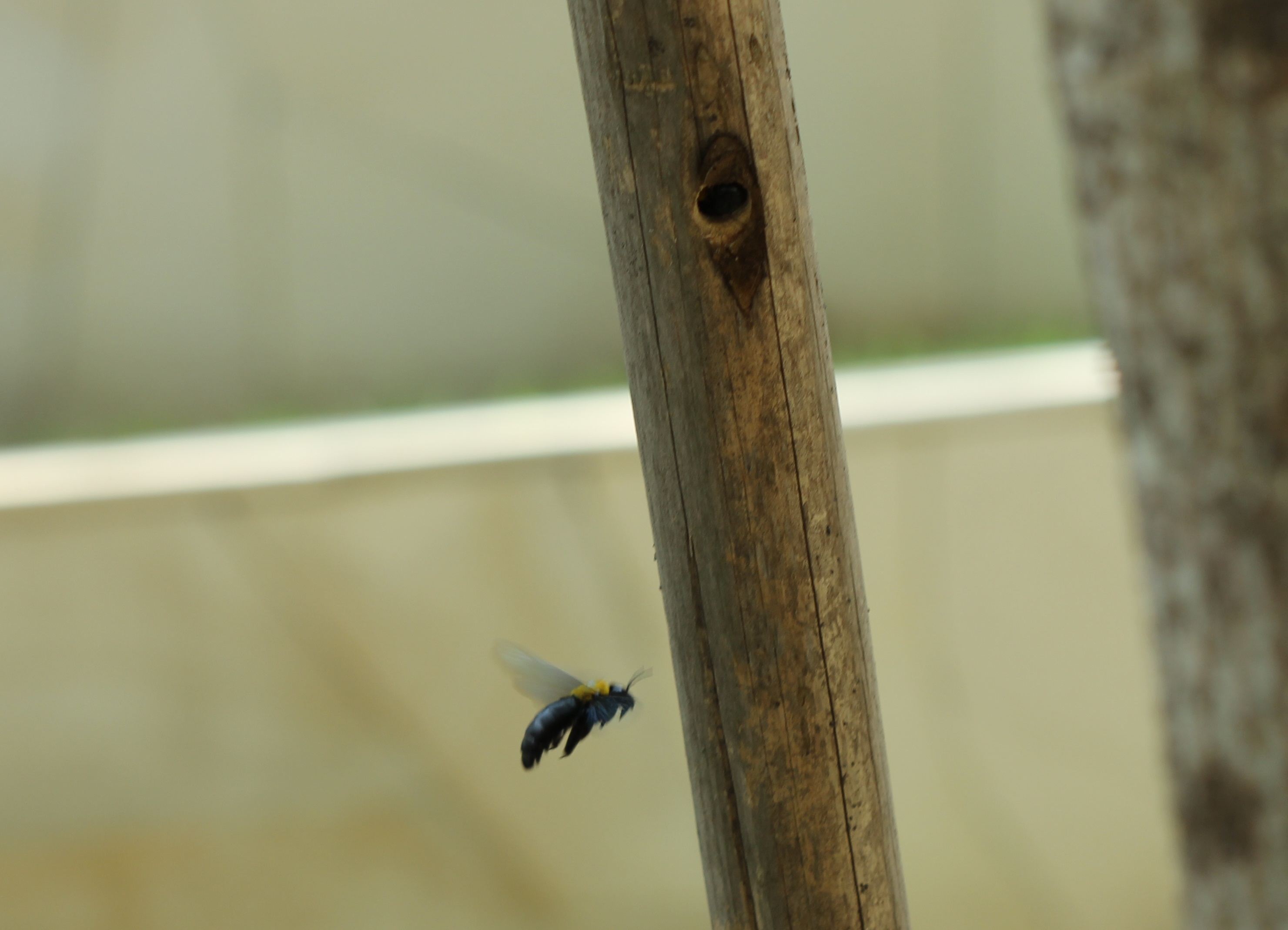 |
| Figure 16. Xylocopa aestuans exiting its nest for a foraging trip (Animation by Kia Yi Ng) |
Figure 17. Xylocopa aestuans returning from foraging trip (Photo by Kia Yi Ng) |
[5.4] Young Care
The number of batches of young per annum depends heavily on climate, availability of food and can range from one to four batches which can be produced by the same female successfully [6].After the construction of the tunnels, the bee starts to collect pollen and nectar to form the bee bread. The size, weight and shape of the bee bread is species and resource dependent. The size of the Xylocopa aestuans bee bread is unknown but the following table (Table 1) shows the mass of three other African species of Xylocopa [1].
| Table 1. Bee bread mass and their respective species (edited from Anzenberger, 1977) [1] |
|||
|---|---|---|---|
| Species |
X. imitator |
X. flavorufa |
X. nigrita |
| Mass (g) |
1.2 to 1.3 |
2.0 to 2.1 |
2.4 to 2.5 |
Defense against predators
The behavior of Xylocopa aestuans towards potential threats have not been researched into and the following is from personal observations. When approaching a nest with a camera, the female (unclear if solitary, social dominant or social defeated) stands guard at the entrance of the nest with no display of aggression even when camera is within 5cm of the nest entrance (observation, 2014). Tapping of the wood elicits a buzzing response from all resident bees. There have been incidents of bees flying out of their nests and hovering in observation of the potential threat.
| Figure 18. Bee looking out of nest for potential threats (Photo by Kia Yi Ng) |
- Loud buzzing
- Biting of irritant with mandibles
- Defecation projectile out of nest entrance
- Display and positioning of sting to face outside of the hole
- Barricading the entrance with her abdomen, bracing her body with her legs sideways
Carpenter bees in general however, are not known to be aggressive and the risk of being stung by one is relatively low. They would mind their business and would much rather get away from you unless severely provoked (eg. poking your finger into their nest entrances). So do not be overly worried the next time one of them crosses your path while foraging.
[5.5] Life History
The first laid egg (furthest cell in the nest) is the first to hatch. The young will travel towards the entrance of the nest, breaking into and tunneling through all its siblings' cells. This may push the developing larvae to the distal end of the nest [6]. The young will remain teneral (soft and immature in colouring) after the final moult into adults for one to seven weeks and will be fed pollen brought to them by their mother or returning sisters [6]. The new bees leave the nest after their exoskeleton hardens. Xylocopa aestuans can live for up to or exceeding one year so mothers can live to see the hatching of their broods.Life cycle [12]
- Egg
- Larva - Soft, whitish and legless. Commonly lasting for about 4 moults. The larva gorges itself on food and only begins defecating when the food supply is almost dimished. The last part of the larval stage is the prepupa, also known as the defecated larva.
- Pupa - This is a rather rapid stage as development occurs quickly. They start to develop the structures of the adults
- Adult - For some bees, like the Xylocopa, the adults remain teneral for a period of time before acquiring full function as an adult.
[6] Ecology
[6.1] Pollination
Xylocopa aestuans pollinate a large variety of flowers. The following are examples of flowers that the species frequents. Xylocopa are important pollinators due to their large sizes (for large flowers) and their long ranges (a longer range will lead to cross pollination across larger distances). The following plants have been observed to be associated with Xylocopa aestuans (observation, 2014).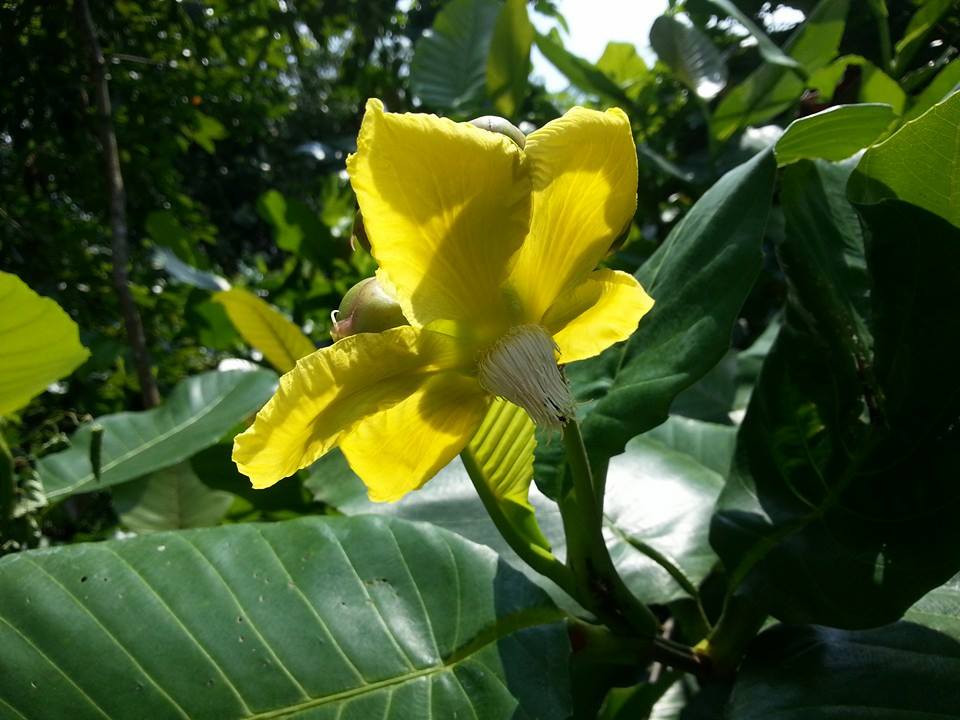 |
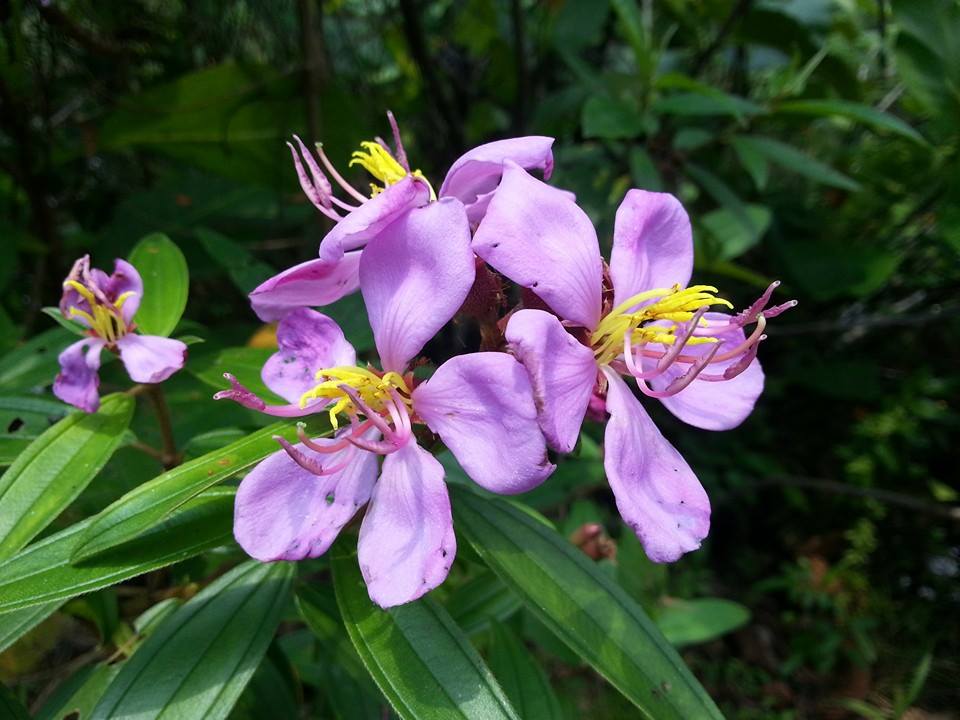 |
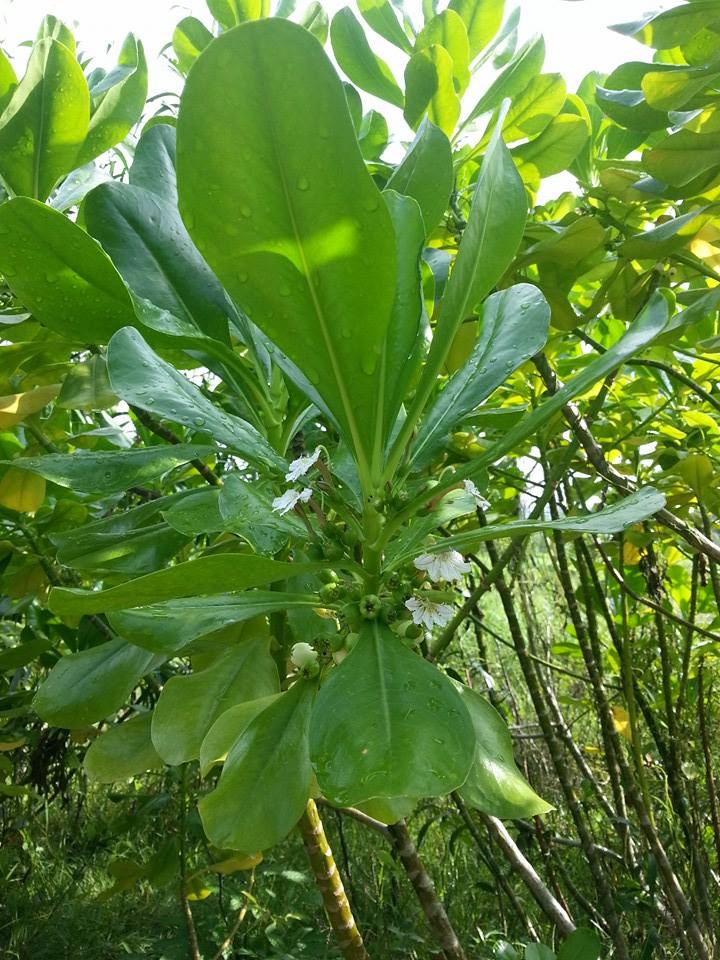 |
| Figure 19. Dillenia suffruticosa (Photo by Kia Yi Ng) |
Figure 20. Melastoma malabathricum (Photo by Kia Yi Ng) |
Figure 21. Scaevola taccada (Photo by Kia Yi Ng) |
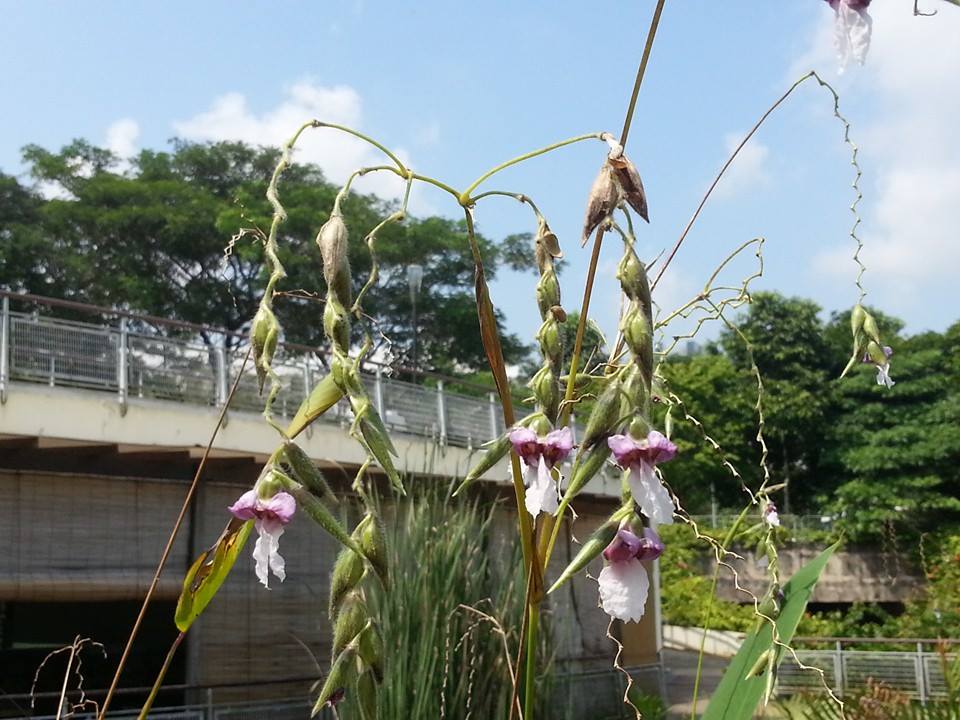 |
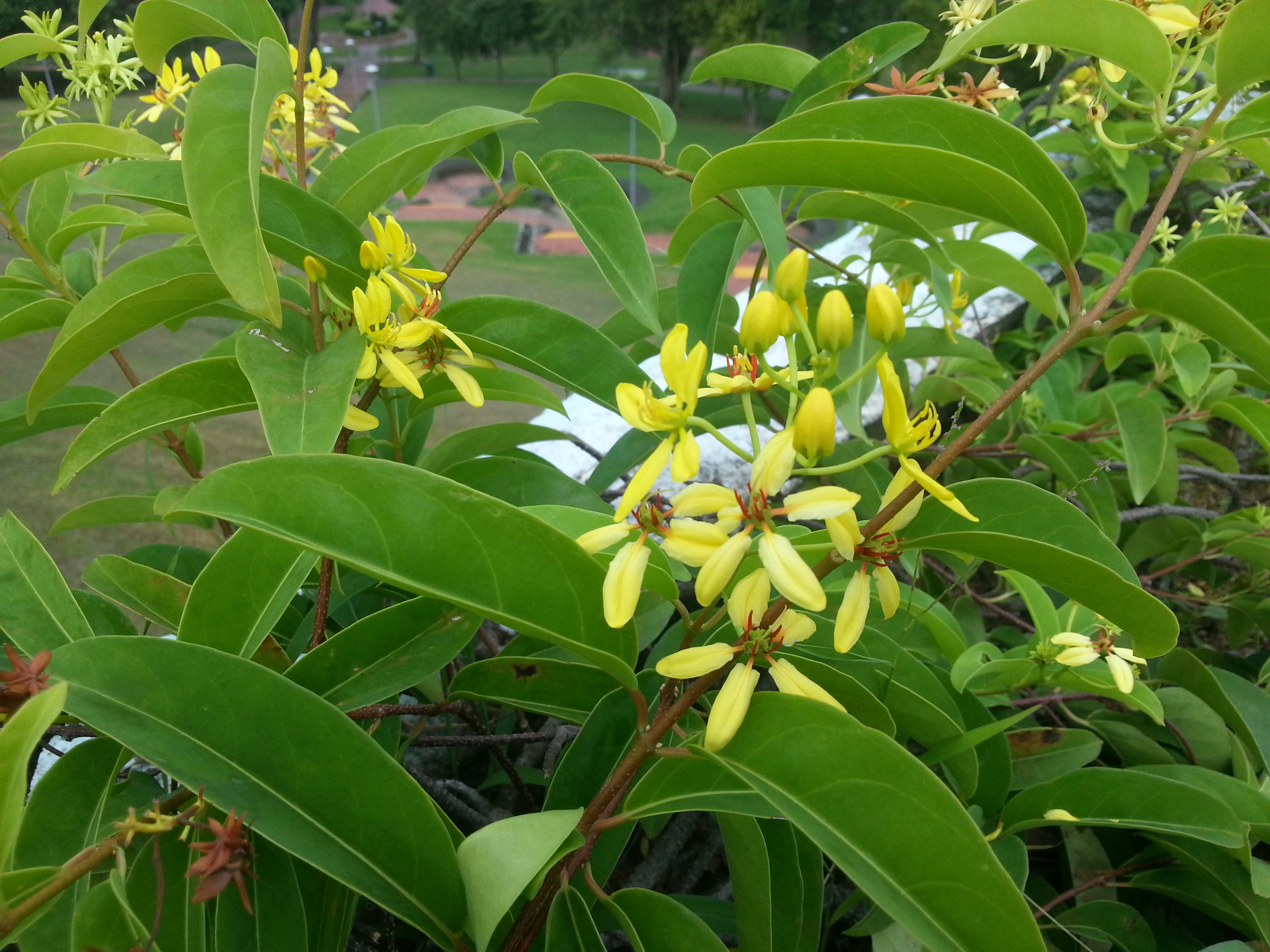 |
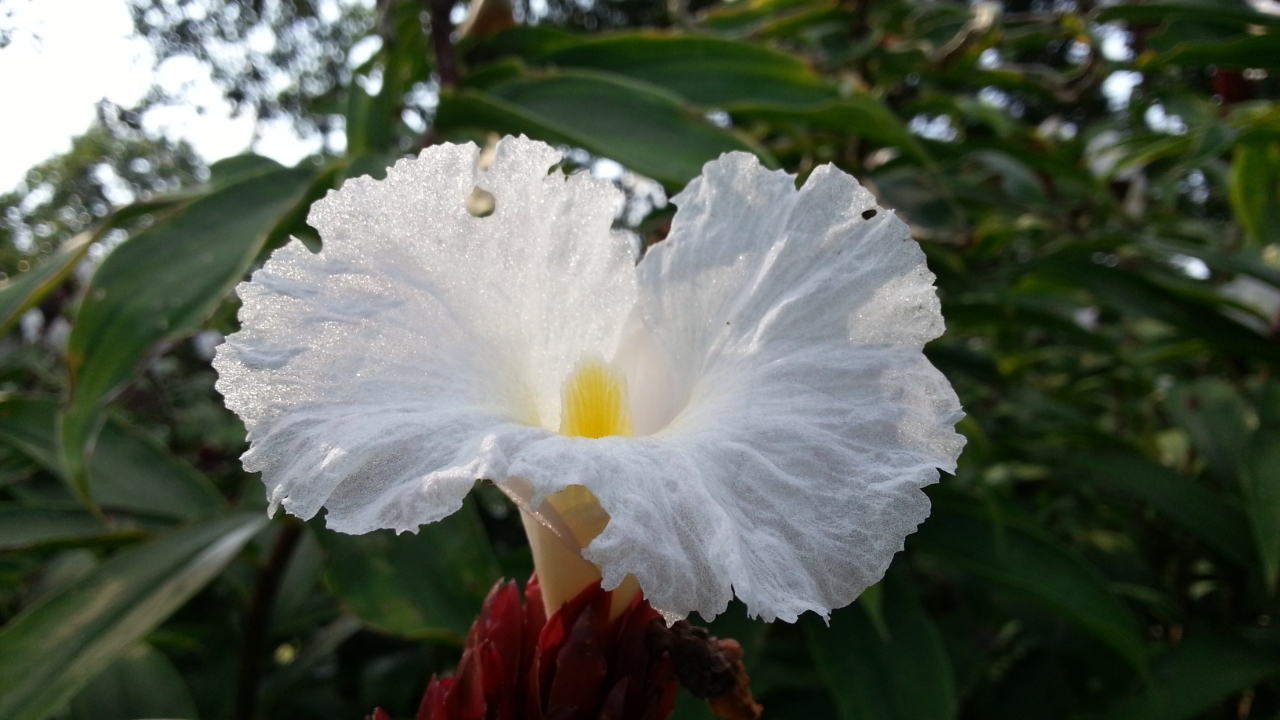 |
| Figure 22. Thalia geniculata (Photo Kia Yi Ng) |
Figure 23. Tristellateia australasiae (Photo by Kia Yi Ng) |
Figure 24. Cheilocostus speciosus (Photo by Kia Yi Ng) |
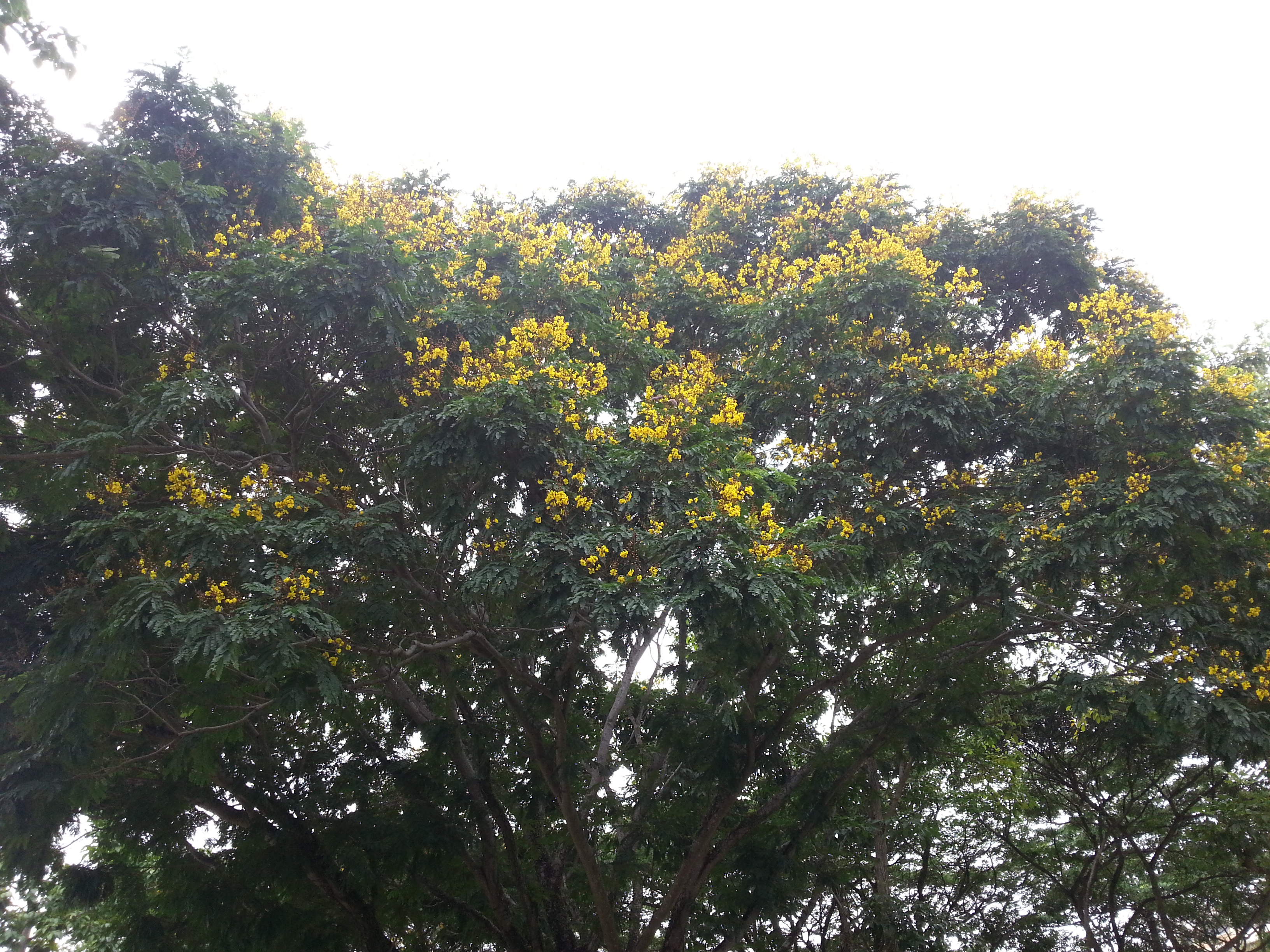 |
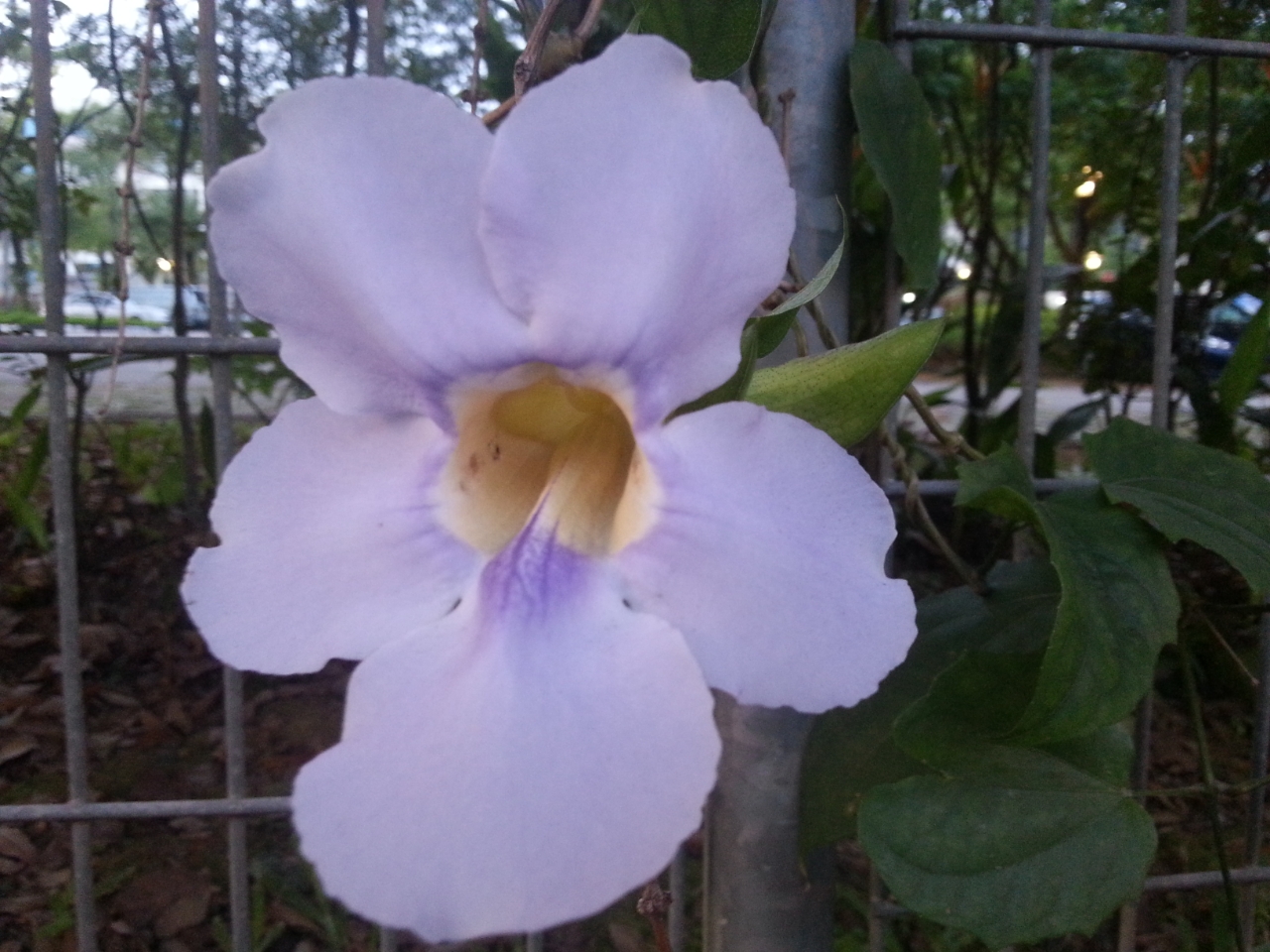 |
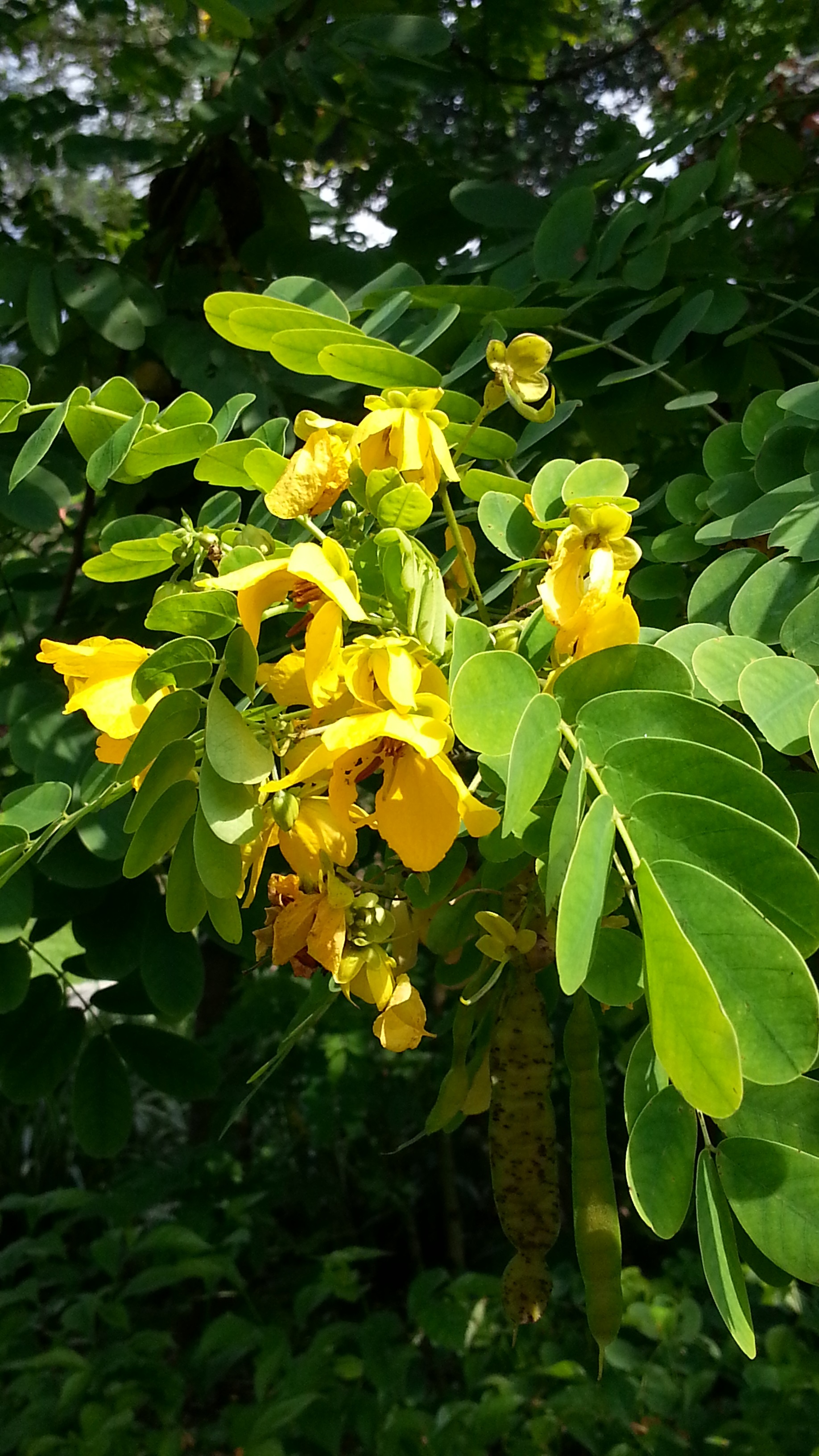 |
| Figure 25. Peltophorum pterocarpum (Photo by Kia Yi Ng) |
Figure 26. Thumbergia laurifolia (Photo by Kia Yi Ng) |
Figure 27.Senna surattensis (Photo by Kia Yi Ng) |
[6.2] Predators, Parasites and Mimics
- Predators - Not much is known about the predators of adult Xylocopa aestuans but it is suspected that various birds and reptiles find it a viable food source.
- Wasps - The young of wasps may parasitise the young of Xylocopa aestuans in cases where gravid female wasps place their eggs into bee nests by sneaking in while the female bee is out foraging.
- Mites - Many Xylocopa species have developed mutualistic relationships (where both side benefits from each other) with mites to the extent that specific species of bees have specialised pouches in their bodies to accomodate specific species of mites [13]. However, the service that mites provide bees are relatively unknown and it is possible that some mites may be parasitic to the bees. Figure 23 shows the presence of mites on the body of a carpenter bee.
- Ants - Poorly guarded or constructed nests are prone to ant invasion which is capable of clearing out the entire nest. Ants may enter unguarded nests and steal eggs, larvae and pupae of the bee [1].
- Mimics - Flies have been found to mimic the looks of a carpenter bee perhaps to discourage predators or for parasitic behaviors. The carpenter bee robber fly (Fig. 29) is not found in Singapore.
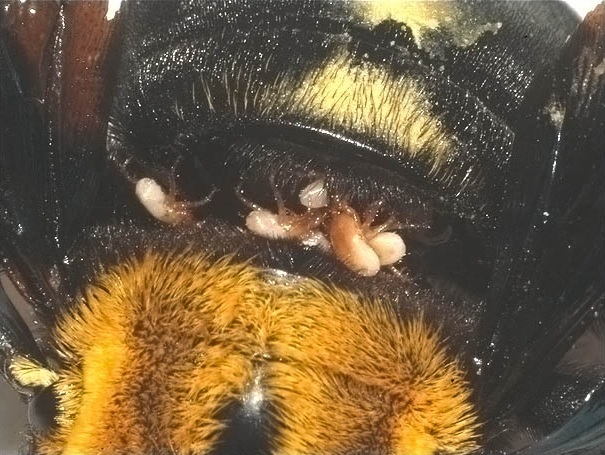 |
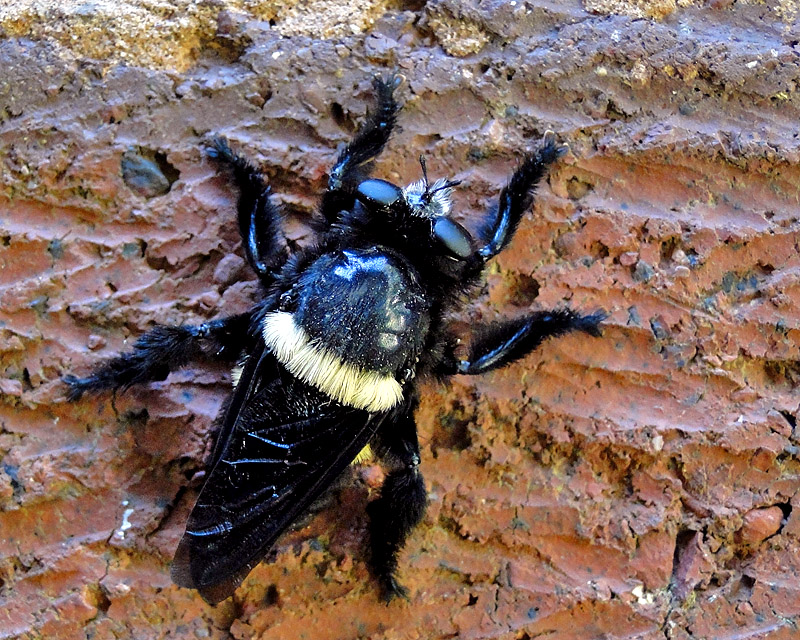 |
| Figure 28. Mites on a carpenter bee (Photo by John X. Q. Lee) |
Figure 29 Carpenter bee robber fly, Hyperrechia marshalli, a carpenter bee mimic. (Photo by Anna Eksteen permission pending) |
[6.3] Xylocopa sp. As A Pest
Xylocopa can cause destruction when nesting in man-made structures such as wooden pillars, garden sheds or even tables and chairs, Their nests weaken the structures and render them useless. Hence, they are considered an annoyance to some people and especially so in parts of the world where housing structures are made of wood. This is less so here in Singapore due to our choice of building materials. In Figure 30 and Video 5, we can see different treatments of carpenter bees whereby one prefers to provide alternative nesting sites while the other uses nest traps to trap and possibly exterminate them.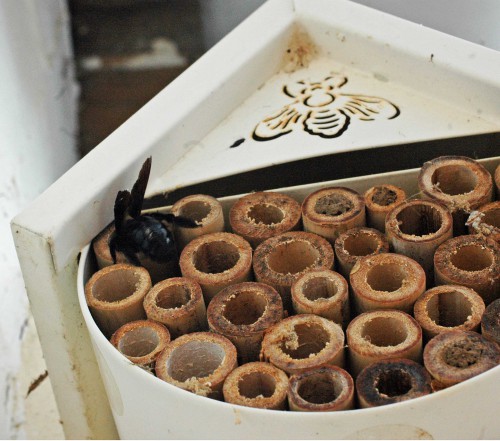 |
|
| Figure 30. An example of a "bee hotel" with the prescence of a Xylocopa violacea (not found in Singapore). (Photo by Nightingale trailspermission pending) |
Video 5. An example of a carpenter bee trap. |
[6.4] Conservation Status
Xylocopa aestuans has not been assessed for the IUCN Red List (IUCN redlist) but from personal observations, is not under immediate threat in Singapore. However, due to the lack of research and information on specific to this species, there may be threats present to the species that we are not aware of. For example, we have limited knowledge about the dispersal abilities (ability to spread and colonise new areas) of this species and hence may be unaware of the stress caused by the fragmentation of green areas (parks, forests and community gardens) in Singapore.[7] Nomenclature
[7.1] Scientific Classification
- Animalia
- Arthrapoda
- Insecta
- Hymenoptera
- Apocrita
- Apoidea
- Apidae
- Xylocopinae
- Xylocopini
- Xylocopa
- Koptortosoma
- Xylocopa (Koptortosoma) aestuans
- Koptortosoma
- Xylocopa
- Xylocopini
- Xylocopinae
- Apidae
- Apoidea
- Apocrita
- Hymenoptera
- Insecta
- Arthrapoda
[7.2] Phylogenetic Relations
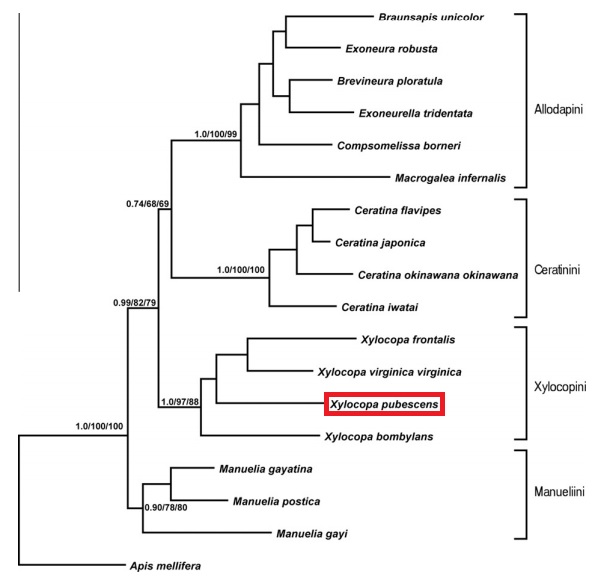 |
| Figure 31. Phylogenetic tree, with Xylocopa pubescens as the representative of Koptortosoma, showing Koptortosoma among other Xylocopinae. [7] |
[7.3] Original Description
Xylocopa aestuans was first described by Linneaus in 1758 as Apis aestuans. It was the dawn of taxonomic classification for various groups of animals and most of the bees described for the first time were simply put under the genus Apis. |
| Figure 32. Screenshot of Xylocopa aestuans as described in Systema naturæ.(Scanned document from the Biodiversity Heritage Library) |
[7.4] Type Specimen
The type specimen is located in Uppsala University, Museum of Evolution |
| Figure 33. Record of Xylocopa aestuans type specimen on Catalogue of Type Specimens: Linnaean species. Uppsala University, Museum of Evolution. Image obtained from Uppsala University, Museum of Evolution [11] |
[7.5] Name Confusion
There has been much confusion as to the locality of the type specimen as the records by Linneaus was non-specific. The female bee was recorded as to have been found in "Habitat in calidis regionibus", which roughly translates to "hot place" (Fig. 34). |
| Figure 34. Screenshot of location as described in Systema naturæ.(Scanned document from the Biodiversity Heritage Library) |
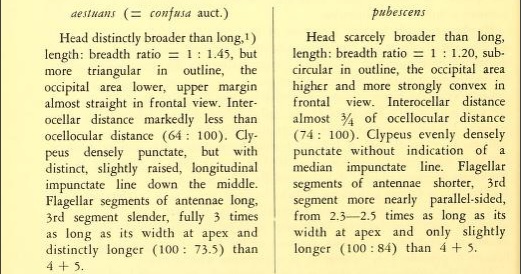 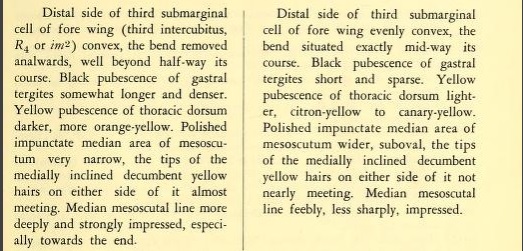 |
| Figure 35, 36. Text description on the morphological differences between females of Xylocopa aestuans and Xylocopa pubescens. (Scanned document from the Biodiversity Heritage Library) |
[7.6] Synonyms
Apis leicothorax (De Geer, 1773)Xylocopa confusa (Perez, 1901)
[8] Credits
[8.1] Photo credits
Anna Eksteen - FlickrJoe - Flickr
John X. Q. Lee - Vespa-bicolor
John S. Ascher - Discover life
Nightingale trails - Nightingale trails
O. Holovachov - Holovachov.com
Zestin Soh - Flickr on Singapore Bee Fauna
[8.2] References
1. Anzenberger, G. (1977). Ethological Study of African Carpenter Bees of the Genus Xylocopa (Hymenoptera, Anthophoridae) 1. Zeitschrift für Tierpsychologie, 44(4), 337-374.2. Ascher, J. S. (n.d.). Xylocopa aestuans (Linnaeus, 1758). [online] Discover Life. Available at: http://www.discoverlife.org/mp/20q?search=Xylocopa+aestuans [Accessed 11 Nov. 2014].
3. Ascher, J. S. (n.d.). Xylocopa flavonigrescens Smith, 1854. [online] Discover Life. Available at: http://www.discoverlife.org/mp/20q?search=Xylocopa+flavonigrescens&flags=subgenus: [Accessed 11 Nov. 2014].
4. Biodiversitylibrary.org, (2014). Biodiversity Heritage Library. [online] Available at: http://www.biodiversitylibrary.org/search?searchTerm=xylocopa+aestuans#/sections [Accessed 9 Nov. 2014].
5. Buchmann, S. L., & Hurley, J. P. (1978). A biophysical model for buzz pollination in angiosperms. Journal of Theoretical Biology, 72(4), 639-657.
6. Flores-Prado, L., Flores, S. V., & McAllister, B. F. (2010). Phylogenetic relationships among tribes in Xylocopinae (Apidae) and implications on nest structure evolution. Molecular phylogenetics and evolution, 57(1), 237-244.
7. Gerling, D., Velthuis, H. H. W & Hefetz, A. (1989). Bionomics of the large carpenter bees of the genus Xylocopa. Annual Review of Entomology, 34(1), 163-190.
8. Hogendoorn, K., & Leys, R. (1993). The superseded female's dilemma: ultimate and proximate factors that influence guarding behaviour of the carpenter bee Xylocopa pubescens. Behavioral Ecology and Sociobiology, 33(6), 371-381.
9. Hogendoorn, K., & Velthuis, H. H. W. (1993). The sociality of Xylocopa pubescens: does a helper really help?. Behavioral ecology and sociobiology,32(4), 247-257.
10. Jones, C. E. & Buchmann, S. L. (1974). Ultraviolet floral patterns as functional orientation cues in hymenopterous pollination systems. Animal Behaviour, 22(2), 481-485.
11. Lars, W. (2011). Catalogue of type specimens. 4. Linnaean specimens. 6th ed. [ebook] Uppsala, Sweden: Uppsala University, p.20. Available at: http://www.evolutionsmuseet.uu.se/samling/UUZM04_Linnaeus.pdf [Accessed 9 Nov. 2014].
12. Michener C. D. (2000). The bees of the world (Vol. 1). JHU Press.
13. Van Eyndhoven, G. L (1964). Acari of the genus Dinogamasus from Koptortosoma pubescens and K. aestuans (Hymenoptera). Tijdschrift voor entomologie, 345.
